To the memory of Leo BeranekNote 1
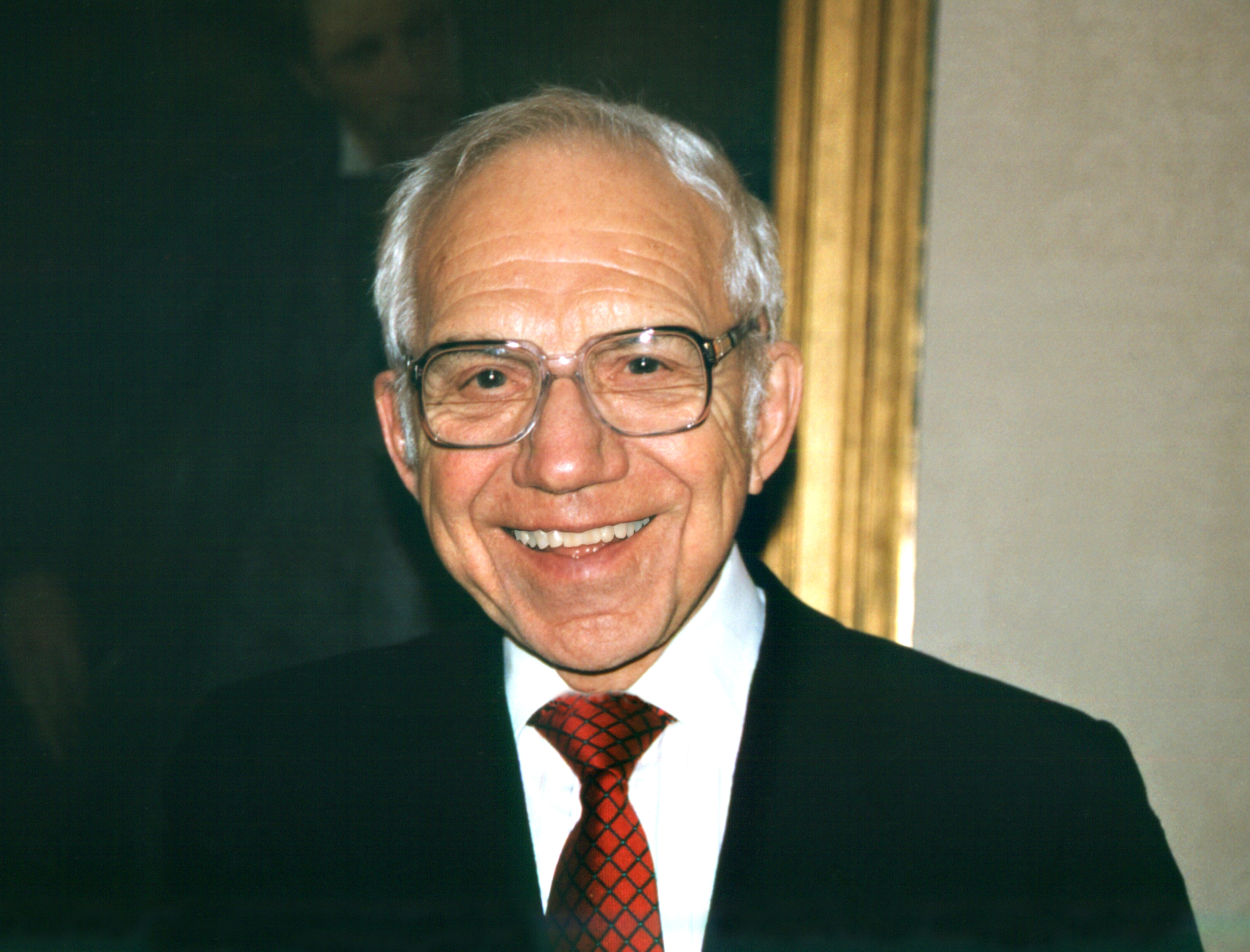
As the remarkable state of the art Hamburg Elbphilharmonie prepares for its 11 January 2017 opening, and with new concert halls proliferating across much of the globe despite an international backdrop of economic and sociopolitical anxiety, now is a perfect moment to step back and ask what the big lessons are that can be learnt from the last half century’s enormous developments in concert hall design.
9,938 words
1. Holy Grail or Glass Bead Game2?
In 2015 Paris got a brand new one. Hamburg is next up with a quite extraordinary one, Sydney’s has always been controversial, Berlin and Vienna both have two really good ones, Munich clearly needs a third one, post referendum London is deciding if it can afford another one, and the traditional consensus is that the best three of all time are in Amsterdam, Boston and Vienna. Oh, and new ones are spreading like wildfire all over the world: Beijing, Dubai, Caracas, Guangzhou, Moscow, Reykjavik, São Paulo and Shanghai being merely eight of some of the more significant recent global examples.
No, not airports. Not museums, nor even football team managers.
Instead, we’re talking concert halls. And although aficionados of classical music must surely be enthused by seeing that hardly a month goes by without yet another article opining upon the merits of the world’s finest concert halls, you do wonder how many of the screaming ‘My top 10!!‘ articles quite hit the most important nails on the head. The last two months brought a slew of articles about the new Hamburg Hall. October had been the turn of Business Insider UK, courtesy of journalist Gus Lubin, and perhaps that one was different. Perhaps. After all here was the stamp of real authority: a piece about a new 2016 research paper on the world’s great concert halls by Leo Beranek, the venerable acoustics expert who recently passed away aged 102.
When it comes to Beranek, I employ the epithet ‘expert‘, in today’s often post-fact prone world, with more than good reason: more than 60 years of professional experience, first hand experience of dozens of concert halls, attention to both the physics of sound and the views of informed listeners, musical fluency, and a grand list of publications to his name including seminal publications such as Acoustics, and Music, Acoustics and Architecture. And in the case of the recent October 2016 article, an interesting new collegiate approach, the paper in question being the product of combining Beranek’s work with that of Magne Skålevik, a senior acoustical consultant at Brekke & Strand Akustikk3
Beranek’s analytical framework has consistently related to the following seven key acoustical attributes of a concert hall: liveness, loudness, clarity, intimacy, spatial impression and diffusion, warmth, hearing conditions for the musicians, and the absence of deficiencies such as echoes or noise. That’s quite a list – actually a beautifully complete one when it comes to halls and acoustics – although it goes a lot further than what many musicians seem to focus upon in practice: the need to have the two often contradictory elements of warmth and clarity in abundant supply.
At first sight the new top ten results offer few surprises. The 10 “best-sounding concert halls” are deemed to be (in order): 1. Vienna Musikverein 2. Symphony Hall Boston 3. Concertgebouw Amsterdam 4. Konzerthaus Berlin 5. Tokyo City Opera Concert Hall 6. Stadtcasino Basel 7. Symphony Hall Birmingham 8. KKL Lucerne 9. St. David’s Hall Cardiff 10. Meyerson Center Dallas.
Regular top 3: Vienna Musikverein, Boston Symphony and Amsterdam Concertgebouw
(Click to enlarge images. Credits – Vienna: https://www.musikverein.at/ – Boston: http://www.lemessurier.com – Amsterdam – Fred George)
But notice that Beranek’s list is titled a ‘subjective‘ one, and that the number of participant ‘experts’ answering the questions was nowhere near sufficient for what statisticians would require to be able to draw really firm conclusions.
These are of course all great sounding halls (Basel, is the only one I don’t know, although it seems a remarkable lookalike for the excellent Zurich Tonhalle). But much also depends – here’s the thing – on what is most important to you in an acoustic (back to those seven key acoustical attributes), and also where you happen to be listening in the hall. Beranek concedes this, and it’s worth quoting him at length here:
“The 17 assessors … fall primarily into two groups. The first group stated that they preferred a hall with high definition and clarity along with adequate loudness, reverberation, and bass. The second group preferred a louder and considerably more reverberant sound with strong envelopment and strong bass
It is interesting that listeners in Boston Symphony Hall can also be divided into two groups, (and possibly three counting those in between) namely, those who like the sound best in the front two-thirds of the main floor and those who prefer the sound in the upper rear second balcony. The difference is readily apparent to anyone by listening to the first half of an orchestral concert on the main floor and the second half in the rear second balcony. On the floor the sound is clear and loud with full bass, with many early reflections, none of which mask the direct sound, and with reverberation that is beautiful. In the rear second balcony the reverberant sound almost immediately follows the arrival of the direct sound and it is loud and completely enveloping. Those who have subscription seats in the upper balcony praise the sound. The author of this paper, preferring clarity to the sound, identifies with the main-floor group”.
All of the above is true, but when it comes to the right seat in the right hall to hear a particular piece of music played by a particular musician/group of musicians, life is considerably more complicated than, ‘shall I take the lively clarity seat in the stalls or the reverberant enveloping one upstairs’?
Three different yet utterly random examples may serve to illustrate this: if I had to choose a hall in which to listen to a Haydn symphony on period instruments in, then I could probably mention quite a few favourite concert halls for this (my all time favourite – see below – dating from 1672) without getting to the Beranek list.
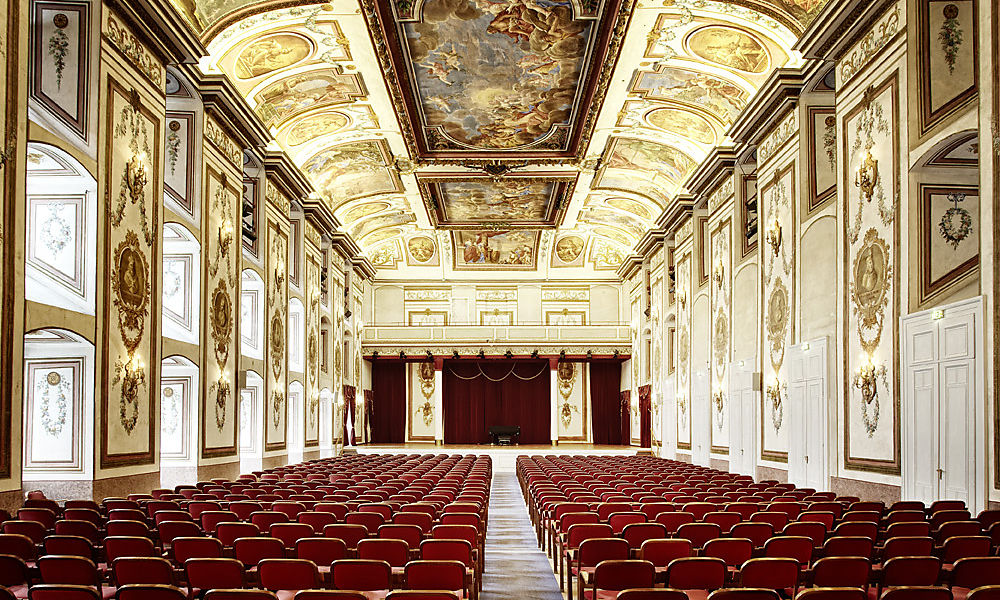
- The Eisenstadt Haydnsaal of 1672: the first great shoebox?
Credit: Roland Wimmer
Now ask on what stage the greatest, most moving number of performances for classical music connoisseurs of big scale Mahler or Bruckner symphonies have happened in the last few decades: I’d probably mention the Royal Albert Hall, a hall housing a potential audience of more than 5,000 which would surely be considered by acoustic experts as one of the less good acoustics of any successful major concert hall in the world. Finally, if I could choose an ideal acoustic in which to hear Schoenberg’s Op. 31 variations played by a first class orchestra, then I might well go for a hall like the Slovak Radio Hall in Bratislava, or if I was really daring, RAI’s super dry Torino studio, two halls that won’t be going on anyone’s top ten list – or probably even top hundred – anytime soon.
And to add further doubt to the detail of the conclusions, consider some information that has come to us from a conversation with Beranek4, from as recently as June 2016, in which it seems that both Beranek and no less a figure than Herbert von Karajan preferred the No. 2 Hall (Boston Symphony) to the No. 1 hall (Vienna Musikverein) in the list. And Ormandy – who was clearly very thoughtful in his views – seems to have actively disliked the Amsterdam Concertgebouw that was at No. 3. And then Beranek comes up with a very interesting – but somewhat contrary – idea as to why these three halls figure so highly:
“Now you must remember that part of the reason that these three halls [Grosser Musikvereinssaal, Concertgebouw and Boston Symphony Hall] get these fine reputations is that you’ve never heard bad music in it. You’ve got great orchestras. And [I] kept feeling there’s something about hearing great music… [Laughs heartily.].”
Lastly, there is the huge question of the variation of sounds in different seats. Who (apart from certain ‘VIP’ types) really wants to sit in row one of the stalls in a single one of the top 10 halls? I am sure that many informed listeners would be happier in a ‘good’ seat in any of the following halls, all of which can be exceptional sounding in the right context but none of which get into that top ten list: Berlin Philharmonie, Konzerthaus Vienna, Tonhalle Zürich, Bridgewater Hall Manchester, Sage Gateshead, Disney Hall Los Angeles, St Petersburg Philharmonic Hall, Tchaikovsky Conservatoire Hall Moscow, Sapporo Kitara Hall, Sala São Paulo, Shanghai Symphony Hall, Paris Philharmonie (see my review last year of Paris here). And then there are a host of new halls that I imagine that I might have added to the list had I experienced them – the new Antwerp hall, Copenhagen’s Koncerthuset, Lahti in Finland, and many from China and Japan. And finally, I have deliberately not mentioned a single Polish hall (the ‘why’ of that decision will become clear below).
The fact is that it is possible to spend years of your life minutely analysing the strict acoustics of this – reverberation times, secondary and tertiary surface reflection volumes and times, diffusion sound envelopes, rear stage wall deflection, degree of bloom, changeable versus static acoustics, shoebox versus vineyard, etc. – and still only have scratched the surface.
Between 2006 and 2007, when the Royal Festival Hall in London was being acoustically reworked, I learnt about the complexity of that surface first hand: I spent a good year and more working with acousticians Larry Kierkegaard and Associates, and learnt the ‘acoustics’ lesson all too well. Days and days went on minute matters like the importance of filling certain grooves in a series of wood panels, what to do with the sound hitting off the hard corners of the boxes, how to deal with the penetrating bass from the Ballroom below, and other sounds from inside and outside of the hall, how to help a certain key artist with the transition to these changes, and other matters, many simply too arcane to detail here. In the course of this process, and also in the ensuing years, something startling happened: I learned to listen to the hall itself, not simply the sound being produced in it. It became like a game of metaphysics, like trying to clear the ‘Lockean’ table of all its contents in order to reveal the true colour of the surface that remained. But of course, there is no absolute true colour.
This kind of thing can end up being a divine curse, an obsession that almost threatens to take your life away: If you’re a real aficionado, a ‘Beranekite’, as I became, it really is like searching for the Holy Grail. But for many audience members and certainly most of a far larger and key group – potential audience members who have never been into a concert hall – it’s more likely to resemble an enforced visit to a not very pleasant Glass Bead Game.
One thing that is interesting is how so much of the conversation in so many of the articles about concert halls has centred around what the basic configuration of a hall is. Of Beranek and Skålevik’s list, by far the majority of the halls are shoeboxes or variations of that type – oblong shape; parallel side walls; height, width and length in approximate comparison to that of a normal shoebox; seating on a flat floor stalls section with additional balcony level(s).
But of the group of halls that have so far been referred to above, whilst twelve are strict shoeboxes, ten others are a curvilinear and/or vertically stacked variation of a shoebox (i.e. a shoebox but with increasingly curved walls towards the stage end, and/or increased vertical ceiling height and an increased numbers of balcony levels more akin to a theatre), four are either unique or else Greek theatre derivations (more about that below); and the remaining twelve are of the newer so called ‘vineyard’ design – tiers of often asymmetric terracing with audiences beginning to encircle rather than simply face the stage, the audience seated in ‘trays’ of varying heights, and with a strong sense of the audience being in the same room as the stage but wrapped around it, rather than facing up towards it.
Whilst the acoustics of these various designs have been extensively mapped by the Beraneks of this world, and whilst one can argue forever and a day about some of the conclusions, they don’t need any restating. So, what’s my point? Quite simply that it is increasingly pointless to discuss the acoustical design of a new concert hall in isolation, because when a hall is put up, there is more, much more, than the one important matter of acoustics going on. Yes, acoustics are absolutely vital. But though excellent acoustic properties are a necessary condition of a great hall, they are not surely a sufficient one, and as a consequence such properties should never be divorced from function. And if form follows function, it is time to consider the concept of function in a much broader manner.
The fact is that when you see the extraordinary ability of concert halls to raise the cultural game, the richness of experience, and the communal vitality of a city, and place that alongside the massive social challenges that all societies today face, then past a certain level of acoustic quality it’s like rearranging the deck chairs on the Titanic to get so involved in a Glass Bead Game level of detail regarding acoustic properties that you fail to notice what that acoustic is there to serve.
And not only that, it’s now really not so difficult to get the acoustics right enough with a variety of hall shapes. As Skålevik himself says “With the objective criteria of today, one can safely plan for a hall that would be somewhere on the scale from good to excellent.” He may have been referring to shoeboxes, but recent history is showing us that that can be true for an interesting range of designs.
Instead, I think that we should be focusing on an additional layer of questions: is the external box that the hall is wrapped in in the right place within the city? Is it doing the right job? Is it value for money? Is it porous enough? (not porous in the sense of sound, but in terms of its openness and accessibility to society). How long-term is the thinking behind it? Can it be delivered on time and budget? What will it do for the city, the region and the people? And – perhaps the most essential question – which people?
In the end this is the biggest rub of all: whilst the acoustics business is a holy grail for the few, it is actually a glass bead game for the many. And that is precisely what is wrong about so many of the ‘top ten halls of the world’ lists. If we really want to understand which are today’s great halls, then we need to look at the question from a variety of angles, and to aid this process, we need to start by understanding the evolution (the aetiology if you like) of concert hall design.
2. From the High Altar to the Open Society
Arguably, the Greek amphitheatre is history’s first great dedicated performance space for the arts, and indeed these curved, steeply raked and democratically arranged theatres appear at first sight as an ideal locus for both audience and performer. But as musicians who who have performed in such spaces know, these designs may be superb for classical speech but they are usually quite dreadful for classical music. Play a note and it drops off a terrifying sound cliff into desiccated silence before you’ve changed bow or drawn breath. Therefore when it comes to concert halls, in the beginning was the shoebox.
But not any old shoebox.
If you think about it then the use of the word ‘shoebox’ suggests, as described above, a very particular structure: approximately between a double and triple cube volume with a flat floor and nothing inside it once the shoes are removed. Except that for more than the last quarter of a millennium5, classical music concert halls were structured within. The stage was always placed against one of the short ends of the box, and often on quite a significantly raised platform. In addition there was a gallery level, which often ended where the stage began.
Now this design concept is quite eerily similar, particularly in terms of functional structure, to that of an oblong early Christian church of the Roman style (e.g. Santa Sabina in Rome, which also has very similar proportions to the Eisenstadt Haydnsaal). Not only is the shape and disposition of the main volume similar, but the mass and placing in the church of a high altar bears an obvious comparison to the raised stage of a shoebox concert hall. For stage read East End, and for performer read … priest (there is surely a fascinating comparison to be elucidated for this latter aspect).
Of course many of these early churches had side aisles, no gallery and other differences from a classic shoebox hall, but in essence both hall and church were designed to have a large congregation on a flat floor all facing in straight serried rows towards the focal point of an elevated plinth, where a select group of exalted initiated specialists ran proceedings according to a fixed set of rituals. This is the concert hall as the socio-cultural equivalent of the church: a high altar shoebox for high art.
And so with the classical shoebox, the structural design has an inbuilt tendency to reinforce particular social contexts, power structures even, for performances. These surely influenced both listener and performer, and one of the most obvious areas for this was the all-important question of where you sat in the hierarchy (hall).
Because the floor was flat, in order for the bulk of the stalls audience to have any view of the proceedings, the stage had to be high off the ground. So the front rows were often an appalling place to be as you had to crane upwards to look at anything. And the back half of the stalls was also often lacking in any feeling of contact with the performance. Sure, many of these halls have a sweet spot somewhere in the mid stalls area or parts of the gallery, but what percentage of the audience sits there? (Check out where the local reviewers sit, and you can probably see how large that area is).
Just as staggering is how badly sited audiences often were in the side galleries. I have been astounded to see that in one of the ‘great’ shoebox halls that usually figures in top ten lists, the view from some of the expensive side gallery seats beggars belief, with huge sections of the strings and wind disappearing from view. And with this distorted view comes a corresponding distortion of balance. In another of the ‘top’ halls, a regular visitor comments, “The ‘problem seats’ are those in the back corners of the balcony, from some of which there is virtually no view at all of the podium” (quote from the Comments Section of the following article: The Problem with building Concert Halls – Financial Times, Edwin Heathcote). In fact to get a proper centralised view of the entire stage the one really good place in most conventional shoebox halls is along the front of the back wall of the hall in the expensive centre gallery seats. Finally, an unimpeded comfortable view; only, by definition, almost as far away from the stage as it is possible to be.
And wherever you sit, the acoustics in these classic high altar shoeboxes was – to go back to Beranek’s list – bright, lively, loud, enveloping, but – let’s be honest – not always overwhelmingly clear. As discussed in Section 1. above, this works well for some repertoire but certainly not for all. In such halls anything from Baroque music with gut strings and light bows to late Classical symphonies can be heaven for volume, bloom and clarity. But for some of the big 20th century repertoire it can easily become overwhelming. Back to our simple acoustic needs: there is plenty of warmth, but is there enough clarity?
So much for the Great Tradition.
London’s 1951 Royal Festival Hall (RFH) was one of the first concert halls to attempt to set this design logic on its head (others did this earlier but more partially e.g. Carnegie Hall in New York adopting an almost proscenium arch-like theatre structure, or the unique Gothenburg Koncerthuset, a remarkable hall in many respects). The RFH was copied in quite a few parts of the world to begin with, and can perhaps best be understood as an iconic transitional space in the phase that followed the shoe box. It grew out of a post-war context in the UK in which culture was beginning to be seen as the right of all in society, and in that spirit, it synthesised a number of previous models to deliver an audience – performer relationship that was, at the time, really quite radical.
A marked but not excessive rake in the stalls allowed a low stage height in relation to the first row of the audience. (The front stage floor height, astonishingly, is below the level of the audiences’ eyes by about row four, and from the first few rows the feeling of intimacy and proximity is a quite exceptional experience). This design created a fundamentally changed experience of performances by audiences.
A substantial set of seats both behind and to the side of the stage allowed the audience to almost envelop the players. It’s true that some shoebox halls (e.g. Amsterdam’s Concertgebouw or Leeds Town Hall) have significant seating to the rear of the stage. However, in these halls the seats behind the stage have no relationship to those in the rest of the hall; it was in the RFH that one saw the first idea of a continuous seating around the stage, even if it remains – in comparison to many later examples – somewhat ‘clunky’ in execution. Finally, an innovative set of boxes jutted out into the hall. With the exception of some side seats, everyone has an uninterrupted view of the entire stage (although of course, one disadvantage is that the rake means that the balcony seats are yet higher and consequently further away from the stage).
Experienced visitors to this hall may well be wondering, in a piece that pays such homage to no lesser a figure than Beranek, why the question of acoustic in relation to the RFH has not been mentioned. Plenty has been said – both before and after its acoustic redesign in the early 21st century – about the dry acoustic properties of this design. But the positives here are not about the acoustics. And in any case the RFH did not remain the new hall on the block for long. A mere twelve years after its opening, a new Philharmonie in Berlin by architect Scharoun became the new model and “the ‘granddaddy’ of all great post second world war concert halls”. Here was the progenitor for the new ‘vineyard’ style.
The depth of Scharoun’s revolution was recently well articulated by Edwin Heathcote in the Financial Times article quoted above. He described the Berlin Philharmonie as:
“arguably the finest and most influential concert hall of the modern age … a truly radical building. A reaction to the symmetry and hierarchy of traditional concert halls, one-time expressionist architect Scharoun designed an egalitarian building that appeared as much like landscape as architecture. … this was a deliberately anti-monumental building, a riposte to the Nazi obsession with classicism, symmetry and solidity. Scharoun’s auditorium is itself broken into parts, its volume fragmented and made informal through a series of staggered terraces that create a topography around the stage. This is the musical version of theatre in the round in which there are no inferior seats. Accommodating 2,440, it proved a brilliant way of expanding the audience without compromising on closeness to the orchestra or acoustics“.
Berlin’s Philharmonie may lack the London hall’s openness to the city and continual day usage, but the positives are utterly winning: excellent acoustics, a really successful democratic wrap around structure for the audience, increased proximity of the further flung seats to the stage than is possible in a large shoe box, and a great relationship between the front of the stalls and the stage, making this not only one of the most revolutionary but also one of the greatest halls of the 20th century. Period.
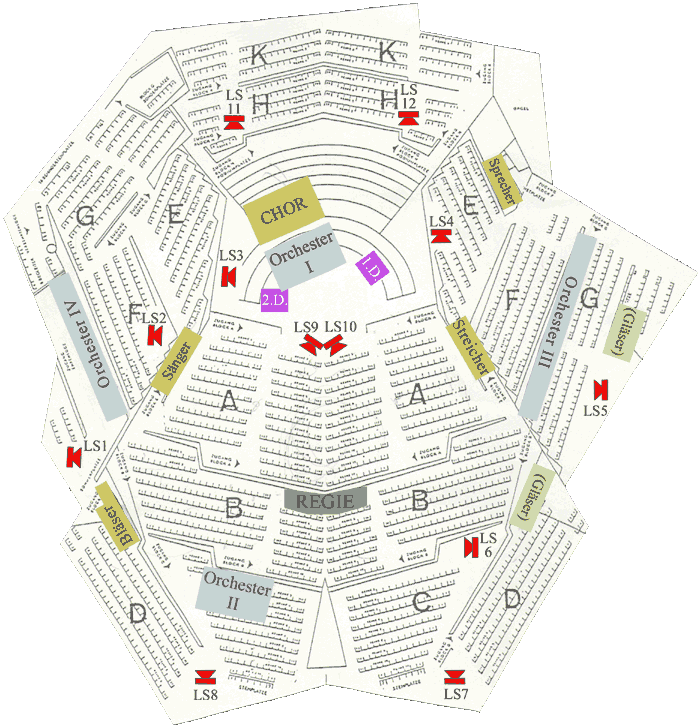
Seating plan of the Berlin Philharmonie:
“a brilliant way of expanding the audience without compromising on closeness … or acoustics”
Looking at the situation by the mid 1960s, one is struck by how far concert hall design had come since the days of the High Altar shoebox. Architects and planners were beginning to respond to a new type of audience – less hierarchical and arguably more eclectic, and a reminder of how society was itself changing. And the fact is that by the Berlin Philharmonie’s opening in 1963, all the elements that make a successful hall were in place, even if it was quite some time before scores of new halls began to exploit the Berlin solutions that are still being employed today. The lessons were there, but absorbing them seemed to take time.
A real change is evident in the 1982 St. David’s Hall in Cardiff (Question to readers: is this really the first repetition of some of the new Berlin ideas? Surely I am missing other halls that are earlier examples of the nascent vineyard design of Berlin). But the most well known hall to really utilise the Berlin model to major effect was Tokyo’s Suntory Hall of 1986, which signalled the arrival of one of the most dominant concert hall acousticians of the modern era, Nagata Acoustics’ Yasuhisa Toyota.
The Berlin Philharmonie is such an influential model then, and its design principles are so clearly evident in so many later buildings, that one is tempted to say that after Berlin, the rest is history.
But not quite.
Not quite, because there were still a couple more developments that the 20th century brought to concert hall design which are worth considering before we step back, and both are visible in one iconic late twentieth century concert hall: Birmingham’s Symphony Hall, opened in 1991.
Birmingham brought to public notice on a new scale the work of the acoustician Russell Johnson. If Toyota is a representative of the school that embraced wrap around vineyards, then Johnson evinces a quite different model. They key thing here is that these two models have now become the de facto major options for almost all new major concert halls. So what exactly did Birmingham do that was so important?
The answer is that in Birmingham they took the old traditional shoebox and made a new altered version that was and was not, at the same time, a shoebox. The stalls were reduced from the length of many traditional High Altar shoeboxes, with an added gentle form of rake towards the rear half of the stalls. Because of these two modifications, the stage was able to stand somewhere between the height of a traditional shoebox and the radical RFH height. A new stalls circle balcony level was added, and a degree of wrap around was provided by seats curving around the rear of the stage, the building shape thus abandoning the traditional right angles of the rear and side wall terminations of so many traditional High Altar shoeboxes. Then extra seats were provided (Birmingham seats 2,262) by ‘stacking’ additional balcony levels – it has four levels if you include the small stalls circle.
And there was something else: In Birmingham Johnson employed a new form of changeable acoustic6. A huge above stage canopy – looking nothing less than a borrowed prop from Star Trek – could be altered in height, and there were large reverberation chambers positioned above and behind the stage with doors that could be fully or partially opened, providing a variety of possibilities to alter the reverberation properties of the hall.
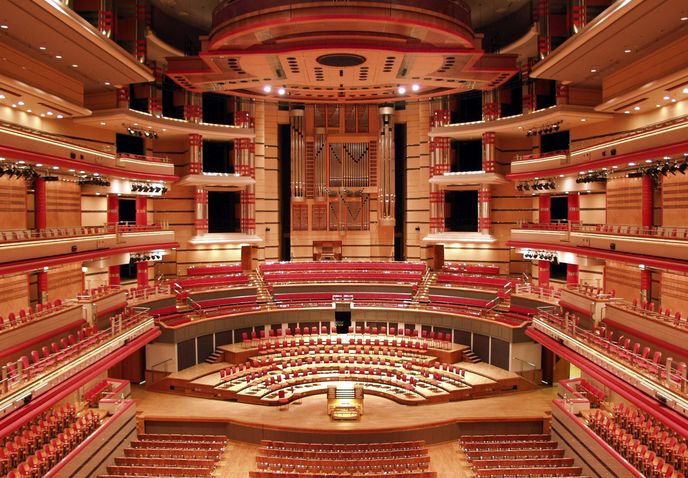
Birmingham Symphony Hall 1991: a view showing the circular variable height acoustic canopy (centre, top, in possibly its highest position) and the reverberation chambers with the doors open (the chambers are visible as square black holes against much of the back wall on either side of the organ). Note also the reduced height of the front stage edge ensuring an improved stage – front row audience relationship, and the large number of circle levels. The gentle rake at the back of the stalls not visible in this photo.
Not surprisingly the changeable acoustic met with differing reactions: although frequently lauded as expanding the possibilities to respond to different repertoire and scale of performing groups effectively, it came in for criticism from a number of acousticians, including it seems some form of questioning from Beranek himself, as is revealed in a conversation previously referred to. This part of the conversation is worth quoting here at length, and starts with a point about New York’s Philharmonic (later Avery Fisher, now Geffen) Hall that Beranek and Johnson worked on together in the 1970s, revealing just how old the changeable reverberation idea really was:
“Leo Beranek (LB:) when [Johnson and I] were working together on Philharmonic Hall even, he said, ‘Why don’t we have some chambers on the side that we could open and close?’ And I said, ‘This is too expensive, too much trouble, we can’t do it.’ And so I prevented them from coming in to Philharmonic Hall. But then he got them into other halls. [Laughs.] But the chamber idea hasn’t been terribly successful.
Willem Boning and/or Ross Urkin (WB/RU): It may be a problem of where the energy goes and that the chambers begin to decouple the response of the room, and it’s maybe not quite as even a response. I went to Symphony Hall in Birmingham recently and the audience was very impressed when the reverberation chamber doors moved at intermission. It was very dramatic when they opened and closed. So it adds to the spectacle.
LB: You heard the difference?
WB/RU: I did. But, you know, I think the intention was simply to change the reverberation time without anything else changing, and of course it changes the spatial balance…
LB: Yes, it does.
WB/RU:… and in Birmingham the reverberation chambers are above the stage and make the sound more frontal and there’s a bit of image uplift and I don’t know, not all coupled sounds sound alike, I guess. It’s not going to sound like the Concertgebouw, this rich, spatially broad, well—integrated sound, somehow.
LB: Well I never saw the two comparisons. Or heard the two comparisons. I was there when they had it where they liked it. And it was fairly good, the Birmingham Hall.”
Recently Toyota has also been described as being “sceptical of this [adaptable acoustic] concept, arguing that the great historic halls are flexible enough to cope with different kinds of music and a modern hall should be too.”7 I’m unconvinced by all of this; it’s true that in Birmingham there is something ‘frontal’ about the sounds with the chambers open, but this is also a matter of trade offs: increase in clarity against decrease in spatial diffusion for example. I’ve heard too many concerts in adaptable acoustics that have delivered some real gains to think that this was not a really interesting development. The devil however is in the detail, and particularly in knowing how to use the detail that is on offer. If you are going to have a changeable acoustic it is absolutely vital to have properly trained staff with good ears who really know how to use it.
So let’s step back for a moment. Summarising the nature of the change from that 1672 High Altar shoebox at the heart of the once supreme Austro-Hungarian Empire to the multiplicity of fantastic constructions that have now spread around so many corners of the globe is actually not so difficult. To begin with is a change that is related not simply to acoustics, but to space, and even, dare I say it, a political concept like egalitarianism: From the rigid hierarchy of unabashed Cartesian dualism towards a more democratised multi-layered ‘multi-view’ space.
And it is not simply about the insides of these buildings. A second change is how the building is placed within the context of the city itself. This amounts to a move from structures that appear to exist, an even float, independently of external space and the city outside, to ones in which the space within connects and relates organically to the ‘urbs’ beyond. Take for example the architects commenting on the new Hamburg Elbphilharmonie: “Our role” says the architect De Meuron “is to connect the old city with the new city beyond”. Or Paris, where the same is true, but the placing yet more radical, the new Philharmonie sitting not at the heart of the old centre, but at the watershed intersection between the old centre and the newer periphery, slap bang between an area of ‘haves’ and ‘have nots’, and thus visible as a symbol of culture at least attempting to bridge the gaps between the varied people that constitute the city. Want a successful concert hall in the 21st century? Then don’t forget about where it goes and who it connects to. It’s as if Einstein had tapped Newton on the shoulder to say, ‘hmm, that old Newtonian shoebox … how about looking at it in 360 degrees ….’
And there we have it. From 1672 to 2017: a 345 year journey from the High Altar to the Open Society.
So much for aetiology. But what does this history tell us about the best types of model for new concert halls as we survey the increasing plethora of world-wide demand? Well first of all that in the need to adapt to changes in society as well as to produce a decent acoustic, the late twentieth and early twenty-first centuries have seen the emergence of two apparently competing models: the amended shoebox variable acoustic that stems from Johnson’s Birmingham Symphony Hall, and the vineyard style deriving from Scharoun’s Berlin Philharmonie, which was later championed most significantly by Toyota, and of which the new Hamburg hall is the most recent major example.
‘Which is better?’ to paraphrase the oft asked question. This is where the wrong type of slanging match can easily ensue. Acoustic so called ‘purists’ (to go back to the study with which this article began) often go for the amended shoebox; vineyard enthusiasts point to the ability to bring more people nearer the music, and build halls with a greater number of seats. Shoeboxers say yes, but – as one shoebox hall programmer recently said to me – ‘I don’t want to have to look across the stage at other audience members, and I certainly don’t want the singer’s back to me!’ And then vineyarders point out that all the big new halls seem to be vineyards these days. ‘Yes’, comes the immediate response, ‘You mean the expensive over budget ones’. And so on …
The vineyard may certainly seem to be king of the large halls – and the large budgets – these days, but the big mistake is to even ask the question in the first place without an understanding of context. Remember Duke Ellington’s simple yet powerful reply when asked what were the best types of music: ‘there is good music’ he is said to have said ‘and there is the other type …’ Same thing for concert halls folks. And to understand why this is so, it’s time to take another turn in the discussion, and indeed to move on to the last section of this essay.
Many cities, countries and continents have been mentioned and alluded to in the narrative so far. But in moving towards an answer to the basic question ‘what makes a hall one of the great halls’, it is time now to focus on one country that has been deliberately almost entirely absent from the story thus far. As I wrote above “I have deliberately not mentioned a single Polish hall (the ‘why’ of that decision will become clear below)”.
Now it is time to look at Poland.
3. Dubai, Wroclaw & Hamburg: Get the questions right, & these cities may well be the answers
Dubai and Wroclaw – let’s be honest – were for the last few hundred years not the first places which the music industry was likely to look to when drawing up their Beranek-type lists. Consider the most recent new concert halls, and Hamburg is anyway the obvious candidate to spring off the tongue these days, with the soon to be opened Elbphilharmonie the biggest story for years, as big as the Paris Philharmonie of 2015, bigger than the intimations of the latest future refit at New York’s Lincoln Center, or the recent news that London has just lost the major portion of its previously agreed government money for a feasibility study into a new hall.
Think about it: on 11 January 2017, exactly one week after this article will first have aired, the city of Hamburg will be the centre of the universe for classical music. It will probably be the only classical music story that day to have ‘escaped’ the classical pages for the hallowed general news pages. Hamburg will have upstaged the premier Alpha+ cities of Paris, New York and London. In most contexts that would be quite a story, the sort of thing that PR companies are paid a lot of money for. And with a concert hall as the PR company, that is exactly what will have happened here.
Why?
Look up information about Hamburg’s new hall, and you can read about an acoustic, architectural and city planning triumph that combines an excellent state of the art vineyard sound design with a crucial role in the urban regeneration of a major German city. And then there is its elemental design: rising majestically in boat like form from the water through dark dock yard brick towards light sky-reflecting glass, with a dancing curved glass roofline that seems to wittily doff its cap to the Berlin Philharmonie. The entrance is along a seemingly never-ending seductively angled escalator onto a complex set of public spaces that include free access to panoramic outdoor views onto the city and beyond, and all of this is before even experiencing the highly praised acoustic of the main hall. Surely this is destined to do for Hamburg what Gehry’s Guggenheim did for Bilbao and his Disney Hall for downtown LA.
Want to see what this feels like in the flesh? Then try interactive link in the address above, or better still, the unashamed ‘full on’ publicity of this advance tour:
https://countdown.elbphilharmonie.de/en/slowmotion/
But as with many of the best stories, there are also some pretty painful stings in the tail: nine and a half years in the building, six years late, a legal, financial and planning nightmare that’s taken the determined commitment of an army of people to resolve – and particularly the Hall’s General and Artistic Director, the heroic Christoph Lieben-Seutter – and a final truly eye watering cost of approaching 800 million Euros, making it more than ten times over budget and by far the most expensive concert hall ever built. These are facts that would have destroyed a lesser project managed by lesser people, and not surprisingly they portend brutal criticism as well as heady optimism. A recent review went so far as to describe the project as “an embarrassing white elephant”.
Hang on a second. If the Elbphilharmonie is ‘an embarrassing white elephant’ then we might as well close quite a lot of concert halls and other performance centres worldwide. The fact is that for a handful of super-cities, if the budget can be held (reasonably) in check, if the city really needs a monumentally distinctive marketing symbol as well as a regeneration vehicle for its metropolis, then this may well turn out to be a type of model to follow, even if many residents remain justifiably unhappy at the process of how the Hamburg story actually played out. Long story short: I’ll bet that in the long run it emerges as a real winner, and that London will not be the only global conurbation thinking about this hall from a number of angles.
Yet the interesting fact is that many (perhaps most) people live elsewhere, and are not resident in the handful of world cities that can afford this kind of undertaking. So for every city that wants and can afford an icon that successfully shouts above the terrifying volume of today’s white noise of globalised culture, there are surely dozens of cities that might want a new hall, but can’t afford, and anyway don’t need or want, an Elbphilharmonie. And in the wake of Trump, Brexit and Rienzi, it’s surely obvious that millions of people in that ‘elsewhere’ need a different kind of offer. For the first time since the fall of the Berlin Wall and the destruction of the Soviet Union the tectonic plates of civilisation have opened and are in serious flux: the naively promised ‘end of history‘ has proved to be nothing more than a chimera, and multiculturalism is under serious, (though one suspects not deadly) fire. It’s a new era that we are entering.
And this is precisely where our friends in Wroclaw step in.
Whilst Paris and Hamburg have been through enough angst to last – if not an eternity then certainly a number of half-lives (some people will know exactly who I am talking about here) – and with London’s new project swaying backwards and forwards, Poland has been quietly and confidently getting on with things in a way that may surprise some. But not those who know the country well. So significant new halls from the last half decade are up and running in at least five places in Poland, counting Luslawice, Katowice, Krakow, Szczecin and Wroclaw8. And of course if ‘new’ is not what you want, then Warsaw already has a great traditional shoebox in the shape of the stunning, well upholstered Philharmonic Hall.
Of the new halls in Poland, the beautiful Krzysztof Penderecki European Music Centre in Luslawice and the Szczecin Philharmonic both seat fewer than one thousand, with the Penderecki hall part of an impressive and thoughtful residential retreat for talented emerging artists, the brainchild of Krzysztof and Elsbieta Penderecki. As I saw on a visit, their vision, drive and commitment will no doubt ensure the success of Luslawice on the international chamber music and small to medium-sized orchestral circuit, but with its size and isolated location, the hall was never meant to play a regular big symphonic function, whilst the ICE Congress Centre in Krakow, though seating over two thousand, focuses much more on a broad-based entertainment programme.
So from these five new halls, it is the ones in Katowice and Wroclaw, with beautiful designs and state of the art acoustics (the former by Toyota and the latter by Tateo Nakajima with ARTEC) that are the two ‘great symphonic halls of the world’ candidates from the new Polish offering. Having toured round and listened to both halls in rehearsal and concert, I think that the comment by Jonathan Sutherland in the May 2016 Bachtrack review9is not entirely unfair: “the difference in timbre between the two venues is akin to that of a New York Steinway (Wrocław) and a Vienna Bösendorfer (Katowice) … both are unquestionably superb instruments“. (my italics)
Both halls have found favour with local audiences, and quickly attracted world class orchestras. What really separates them though is their siting within their respective cities. Whilst I was working at the Festival Hall in London, almost a decade ago, the Wroclaw team came to visit as part of their design stage for their city’s new hall. They asked some interesting questions, drawn, one could easily tell, not simply by the issue of what to put inside of the hall, but also by how the space around it should work. And that approach has now paid dividends.
The eventual cost of the Wroclaw hall was around 100 million Euros. That’s considerably less for a new multi hall building than the final budget for London’s 2005-7 Festival Hall refurbishment, about a third of the cost of the Paris Philharmonie, and almost an eighth the cost of Hamburg. And apparently 20% of that figure went on a new underground car park. Besides somewhere to hide a few hundred cars, that money bought a box containing not only four halls – an 1800 seat symphonic hall plus three smaller spaces (one of which could serve as a rehearsal room for a symphony orchestra) – but also spaces for recording studios, chamber music rehearsal, an educational center, exhibition space, offices and a vast entrance foyer. And like Katowice, but unlike so many traditional concert hall buildings, it has a backstage that does not resemble the servants’ quarters, but is instead of a similar quality of finish to the front of house and the halls themselves. As I walked the back stage earlier this year it felt more as if I was in the offices of a successful commercial company than the often cramped quarters of a number of long-suffering arts establishments.
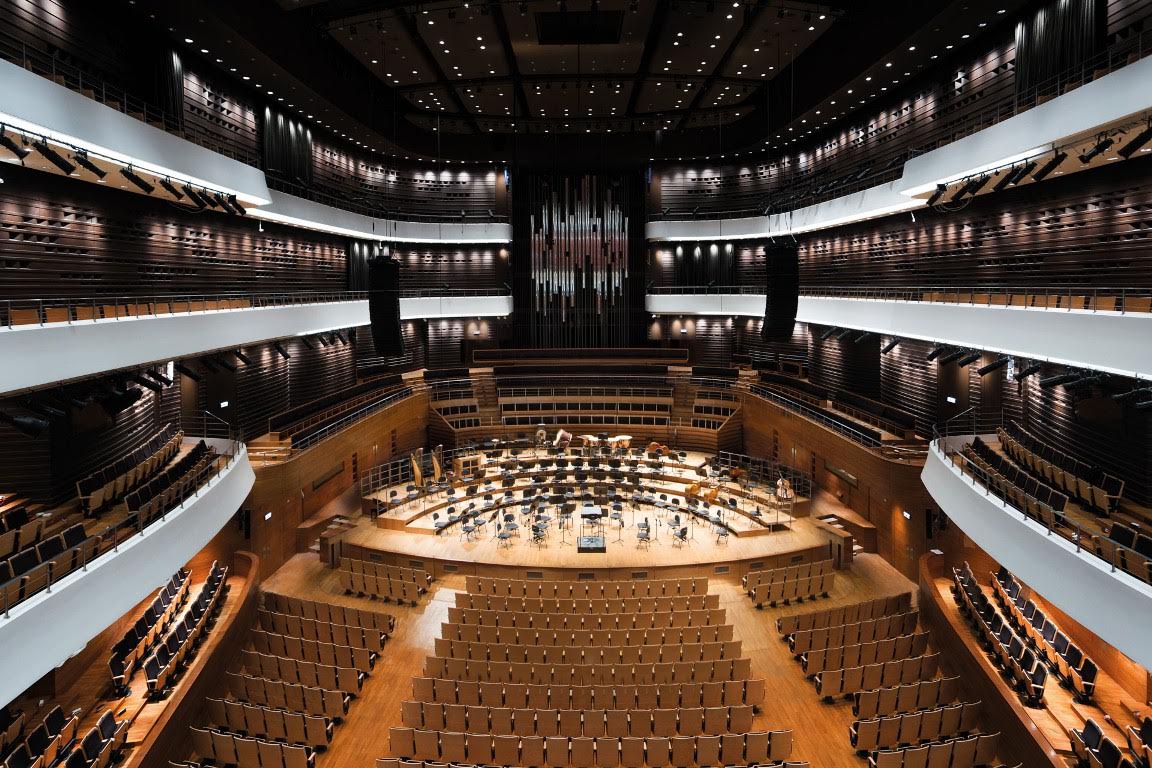 Wroclaw’s new 1800 seater hall in the National Forum of Music
Wroclaw’s new 1800 seater hall in the National Forum of Music
The main hall, again like Katowice, is an undoubted acoustic success. A modified ARUP (i.e. ex-ARTEC) shoebox with that variable acoustic so argued over in the above quoted Beranek interview, it offers seating with a good view from just about everywhere, good sound throughout, a really impressive stage to audience relationship, and a stage design that works beautifully for the musicians. And I can testify from personal experience that the variable acoustic can be a huge help (I watched the acoustic being ‘tuned’ with a particularly large symphony orchestra during a rehearsal last year, whilst hopping between different seats to listen to the effects of that variation throughout the hall). Lang Lang called it “one of the best concert halls in the world”. And here are reactions from an impressive assortment of worthies following its opening in September 2015:
“In addition to being an attractive concert venue, its acoustic allows a wide range of expression, combining warmth and clarity of sound.” Semyon Bychkov
“the ideal acoustic for a symphonic repertoire as we performed in September 2015.” Zubin Mehta
“an immediate warmth, which you feel in your body.” Ivan Fischer
“amongst the very finest [halls] in Europe.” David Whelton, ex Managing Director, the Philharmonia
“A unique acoustic treat … an amazingly blended sound while keeping the highest transparency.” Stefan Englert, Executive Director Budapest Festival Orchestra.
But that’s not all. Actually it should only be considered the beginning. For in addition to excellent acoustics, a well thought out main hall, and a wide-ranging suite of facilities, what is also strikingly impressive in Wroclaw is the way that the building sits within the city, and not just spatially, but viewed through the prism of both its long history, and its recent cultural development. And it is these factors – just as much as the realisation of a Beranek like acoustic dream – that informs the potential success of Wroclaw.
The original brief in Wroclaw – from way back in 2005 – refers to the need for excellence of acoustic, architecture and function, and it has really succeeded in the last of these. An immense four story window has been pierced into the huge horizontally banded façade, creating a palpable sense of grandeur but – just as important – opening itself to the city. A large oblong of a square leads to this front entrance from one of the city’s main road arteries via the Wroclaw Opera and, off to the side, the beautiful Historical Museum, an approach avenue just as impressive as that achieved, say, in Birmingham. With intelligent curation, this square can become an extension of the building itself, and a new cultural town square to balance the more traditional Market Square a few blocks away. And as you enter the building itself you encounter a real sense of drama, with steps sweeping down as well as up to the various levels, and the outside of the huge back wall of the main hall facing you in a single gently curving sheet of reflective black corian.
Interestingly, the new building is not simply a new hall for the local symphony and some swish visiting orchestras, but the National Forum of Music for Poland, a name that certainly signals intent. The main inhabitants are the Wroclaw Philharmonic, but it’s worth noting that between 2005 and 2015 that organisation jumped from having one to eleven resident ensembles, expanded from delivering two to seven annual festivals, and increased its education programme from a dozen or so events a year, to hundreds. According to Director Andrej Kosendiak, in the first year of events more than half a million people attended. Here is a story that evidences not only ambition, but also planned expansion.
Wroclaw, the fourth largest city in Poland and capital of a province (Silesia) with several million people and an urban population of over 600 thousand, is comparable to hundreds of cities worldwide in terms of size, hinterland and scale. With a fascinating polyglot history – part of Moravia, Bohemia, Germany and Poland at different times in its life, practically equidistant from Berlin, Prague and Warsaw, it remains resolutely Polish yet undeniably European.
In the years following the Second World War the city developed significantly as part of big alterations to Poland’s political situation. First came the change from being Breslau (the old German named town) to Polish Wroclaw, then the freedom flowing from the demise of the Warsaw Pact in 1991, and latterly the huge developments that took place after Poland took up EU membership in 2004.
If it does not quite have the tourist cache of not so far off Krakow, Wroclaw has nevertheless built up an impressive cultural life, and with Kosendiak leading the Orchestra, the decade since EU membership has seen a significant bottom up development of activities, allowing the new hall to really take advantage of this prior expansion. Think of it as the polar opposite to some well-known examples where you put up a great hall, bring in some stars for a grand opening, and then try to persuade the audiences to keep coming.
Wroclaw has shown, instead, the benefits of organic growth, the new hall adding to what was already happening, not trying to function as an overnight sensation. Add a fast comfortable Pendolino train from Warsaw that now brings you from the capital in 3.5 hours, and a five-minute taxi ride from the rail station into the city centre to the Hall, and you can see the unarguable logic: the right sound in the right hall in the right place at the right time. Civic planning avoiding civic hubris.
The lesson is becoming clear: you can have the greatest acoustic in the world but if a hall is to be successful today it also needs the right context, in space, but also in time. What and Who does your hall represent for the city are vital questions, as is the big big issue of how to reach out to new audiences. And the final key challenge (perhaps in the end the most tricky) is to successfully plan far enough ahead. When one considers future needs – think decades into the future, not simply the next five years – then there is one last example that shows that concert halls can probably be taken successfully into some less obvious locations when they can afford to play that long game and think creatively.
Dubai. I am standing at the foot of the world’s (currently) tallest building, the improbably slender, needle-like Burj Khalifa. The building’s 160 floors seem to hold the Guinness Book of Records not simply for being the tallest building in the world, but also for holding the largest number of Guinness Book of Records in the world. Big, wealthy, sophisticated yet undeniably ‘brassy’, Dubai is well beyond the obvious traditional remit of western classical music. Down the road, Abu Dhabi has the impressive Abu Dhabi Music and Arts Foundation and its Festival, and not so far off places like Doha and Muscat have orchestras and opera houses. But Dubai, with its state of the art beach ‘resorts’, luxury shopping mall culture, modernist architecture and humming nightlife seems a paean to anything but concert life. Yet it is here that the Middle East’s most interesting performance centre has recently been created in a new area of Dubai’s downtown.
As a European Ambassador stationed in the UAE explained to me recently, one of the impressive aspects of today’s United Arab Emirates (Dubai is one of the seven Emirates making up the UAE) is the tendency to think long term. Half empty ten lane roads and massive construction projects have been cleverly engineered with the aim of being future proof. In myriad ways, thought is being given not simply to what is needed in the next few years – the ‘business as usual’ approach of the election term myopia that dominates so many planning cycles in western capitals – but more in terms of the next few decades. And the new Dubai Opera, nestled in its own burgeoning Opera District, is a good example of such long term thinking.
So the new Dubai Opera building has been placed centre stage in the bustle of the new downtown Dubai, linked by footbridges across a new lake to the Burj Khalifa, the enormous Dubai Mall and the Souk al Bahar, in an area already seeded with art galleries, museums, design studios, hotels, and residential towers. All of this is within a short taxi ride of the many beach resorts of Dubai’s coast line. Abu Dhabi is not much more than an hour’s drive south west, Sharjah is just up the road, classic desert scenery is within easy reach, and the nearby airport is a hub for intercontinental flights to just about anywhere. The population of Dubai is around 2.5 million, but the active daytime population is said to increase by almost another million. You can, again, see the logic: if you can get the design and the programming right, here is a massive constituency of people with disposable income. Of course this is a challenge: there may be people and there is certainly money, but this is hardly a city drowning in centuries of western cultural tradition, and to be honest, many of the visitors are here for anything but culture. So what would be needed here is a far more flexible approach than in the ‘Hamburgs’ and ‘Wroclaws’ of the world.
And this is exactly what the new Dubai Opera seems to have delivered. The new hall seats almost 2,000 in a clean design with excellent views of the stage from all seats (the spec. claims that no seat is further than thirty five metres from the stage), and a bright lively acoustic includes a new individual-seat air conditioning system that eradicates a sound problem suffered by many otherwise excellent new halls. But the hall’s real secret is its flexibility, which is unlike anything that I have encountered before.
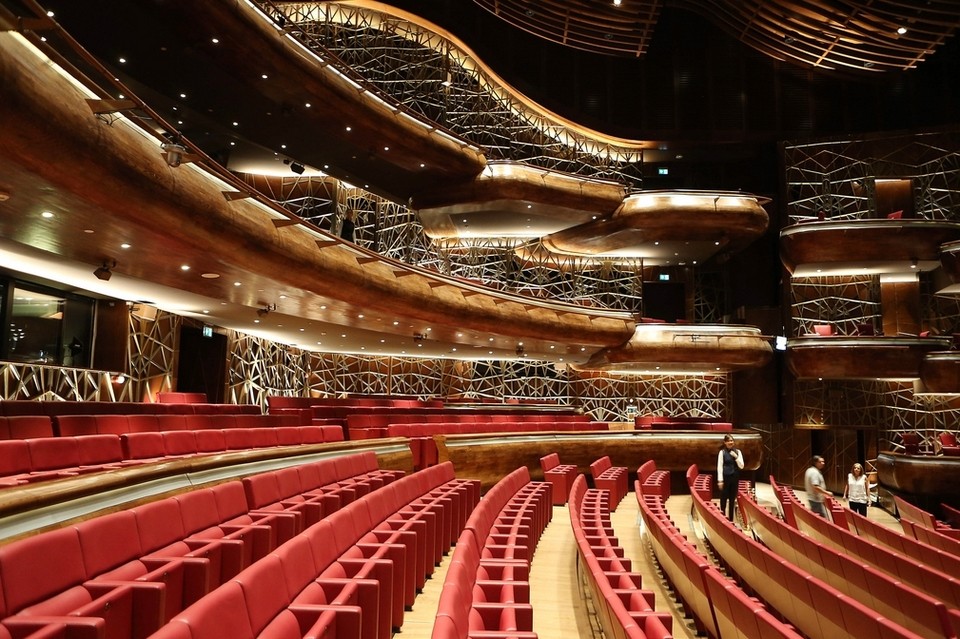 Interior of the new Dubai Opera
Interior of the new Dubai Opera
(Credit – http://www.srltsl.com/dubai-opera-house-opens/)
Floors, walls and ceilings can be moved electronically depending on the space requirements, 900 of the stalls seats can be hidden beneath ground, and the entire set of stage side boxes can be removed at the press of a few buttons. The result is a multi-function space that can be used in at least three different configurations: as an opera house/musicals theatre, a concert hall, or as a flat-floor space. As well as the main hall there is a studio designed for anything from chamber music concerts, to orchestra and ballet corp rehearsals. Huge foyer spaces with multiple floors of vertical glass wall look outwards, with an open plaza behind and a new landscaped park and the Burj Khalifa lake at the front. Presenting itself from outside as a dramatic traditional dhow shaped boat, the park, lake and plaza will give Dubai Opera the space to dominate the surrounding area in contrast to the jostling skyscraper architecture of much of downtown Dubai. The result is a calm civilising space within the otherwise frenetic density arising throughout the city. Architect Janus Rostock of W S Atkins and the planners certainly seem to have done their work.
To get the programming mix right Dubai Opera have employed Jasper Hope, an executive who successfully ran the 6,000 seat mixed programme Royal Albert Hall in London for seven years. That was a wise choice: From what has happened so far it’s clear that Hope and his team have the experience and know how to vary the programme and slowly develop the audience. In a recent interview, standing outside of the new building, he sets the context thus:
“You have to start somewhere. In many areas of culture – design, fashion, visual arts – Dubai has more than started to establish itself, but in performing arts it hasn’t remotely begun, and to start, you have to have one of these … It’s a pretty serious statement of intent just having this building; it’s not like these are built every day around the world. Brand new ones – with the latest technology, latest knowledge of what makes a great auditorium, great acoustics, a fantastic experience – are few and far between.”
So here we have three fascinatingly varied templates for successful halls, all with first rate acoustics, and all with a different design approach. Yes, you can wow the global crowd in more than one way, as Hamburg and Dubai demonstrate, but of course, Dubai is a highly unusual situation, and as one of the principal Hamburg architects, Jacques Herzog, says, looking back on thirteen years of ‘struggle’, “The whole thing is really so unlikely … It almost happened by chance, from this individual, whose idea then gained a kind of bottom-up momentum. You could not win with such a thing in a design competition. And perhaps we are the last generation of ‘author’ style architects to have such a chance”. Perhaps that is just the architect speaking. But if not, then in many ways Wroclaw becomes the most important solution, if only because it is likely to be the most effective regular template for the largest number of urban metropolises around the world.
But whatever changes in concert hall design come during the next few decades, one thing is clear: without compromising on acoustics or forgetting the lessons of the late and great Leo Beranek, the old ‘Glass Bead Game’ is over. And as Hamburg flings open its extraordinary doors in a matter of days, and London ponders its next steps in the ‘to be or not to be‘ game of a new hall for the UK capital, context needs to remain as the overriding criteria of what works and what fails.
3 new contexts: Hamburg Elbphilharmonie – Wroclaw National Forum of Music – Dubai Opera
Click to enlarge images.
With such a perspective, the one sure thing that can be said is that the blunt question ‘shoe-box or vineyard?’ can never be answered a priori, but can only be delivered as a successful answer, empirically. Context, context, context.
Marshall Marcus © January 2017
NOTES
Note 1: A fortnight after beginning work on this essay, and having already used a recent article by Leon Beranek as its starting point, it was announced that this great acoustics expert, former MIT professor, writer and a founder and former president of Bolt, Beranek and Newman, passed away, aged 102. Beranek was a towering presence in the world of acoustics for more than sixty years, and without him we would know a great deal less about the best acoustic functioning of concert halls. The influence of his work pervades a significant amount of what follows, and this article is therefore dedicated to his memory. Return to text
Note 2 The Glass Bead Game, a mid-twentieth century novel by the German-born Swiss writer Herman Hesse, concerns an arcane intricately detailed board game studied by an ivory tower group of experts who have dedicated their lives to this one pursuit. The book’s subject has also become seen as a metaphor for the dangers of over specialised and focused pursuit, in which too much concentration on a highly detailed area of enquiry causes a consequent loss of perception of higher level matters. Return to text
Note 3 To access the whole paper open the PDF link at the top right of page 1 on the following site:
http://scitation.aip.org/content/asa/journal/jasa/139/4/10.1121/1.4944787 Return to text
Note 4 the conversation comes in a transcript by Willem Boning of a meeting he had with Beranek in the company of Ross Urken. I mention Urken because it’s not clear to me if the questions and comments that are not Beranek’s are only from Boning, or from Boning and Urken. http://fromthesoundup.tumblr.com/ Return to text
Note 5 I’m dating this from the Esterhazy Eisenstadt Haydn Saal of 1672, for me the very model of the early shoebox concert hall, and although on no one’s recent list of great concert halls, surely one of the greatest acoustics in the world for small scale first Viennese School compositions. Return to text
Note 6 I say a ‘new’ form of changeable acoustic, but of course this is work that had been pioneered elsewhere: my first view of such a thing was on a tour round Pierre Boulez’s IRCAM Pompidou studio in Paris in the late 1970s. But Birmingham was, as far as I know, a new iteration of this in a conventional city concert hall. Return to text
Note 7 From an article in the London Times by Neil Fisher, 31 October 2016 ‘How this sonic wizard makes every maestro’s dream come true’. Return to text
Note 8 https://www.nytimes.com/2014/11/05/arts/music/polands-concert-hall-revival.html?_r=0 Return to text
Note 9 https://bachtrack.com/katowice-wroclaw-concert-halls-poland Return to text
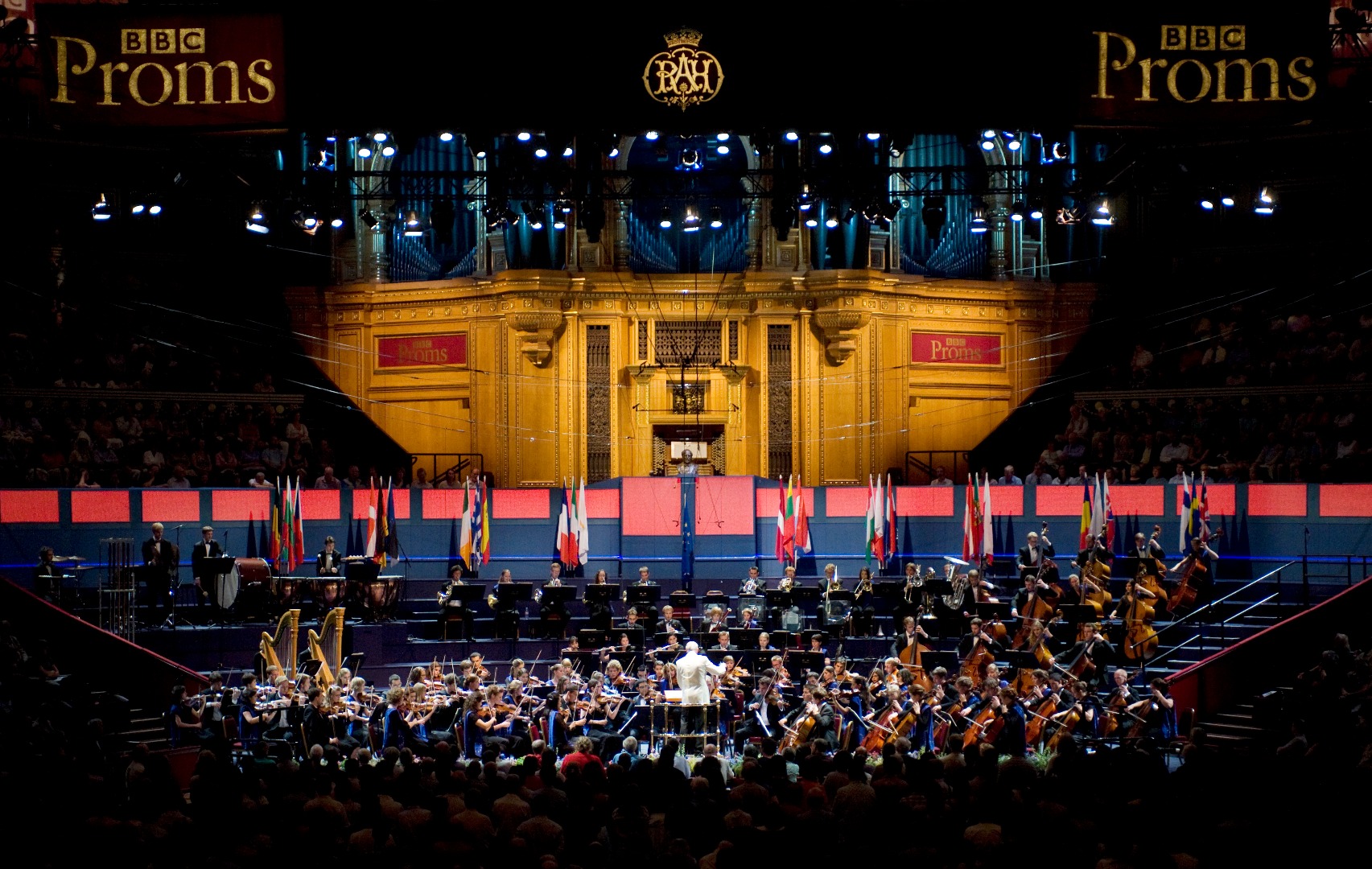 The EUYO performing at the BBC Proms
The EUYO performing at the BBC Proms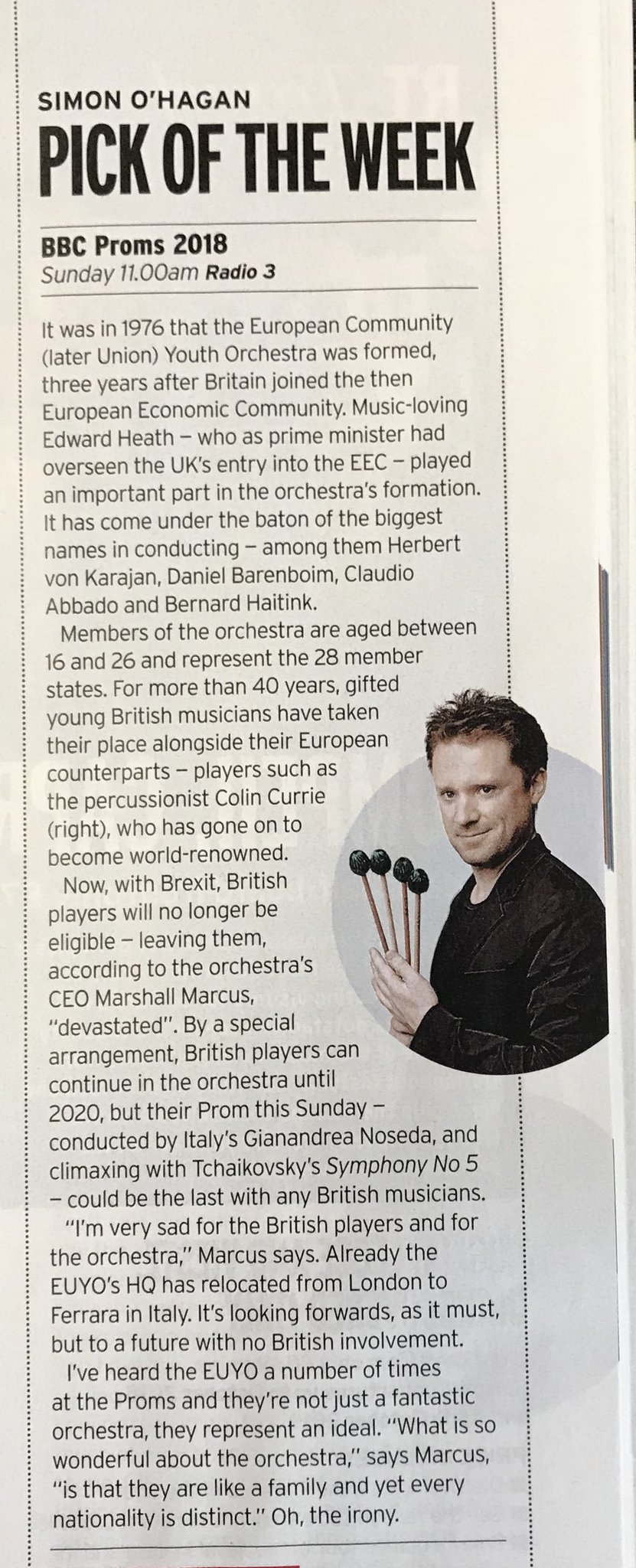
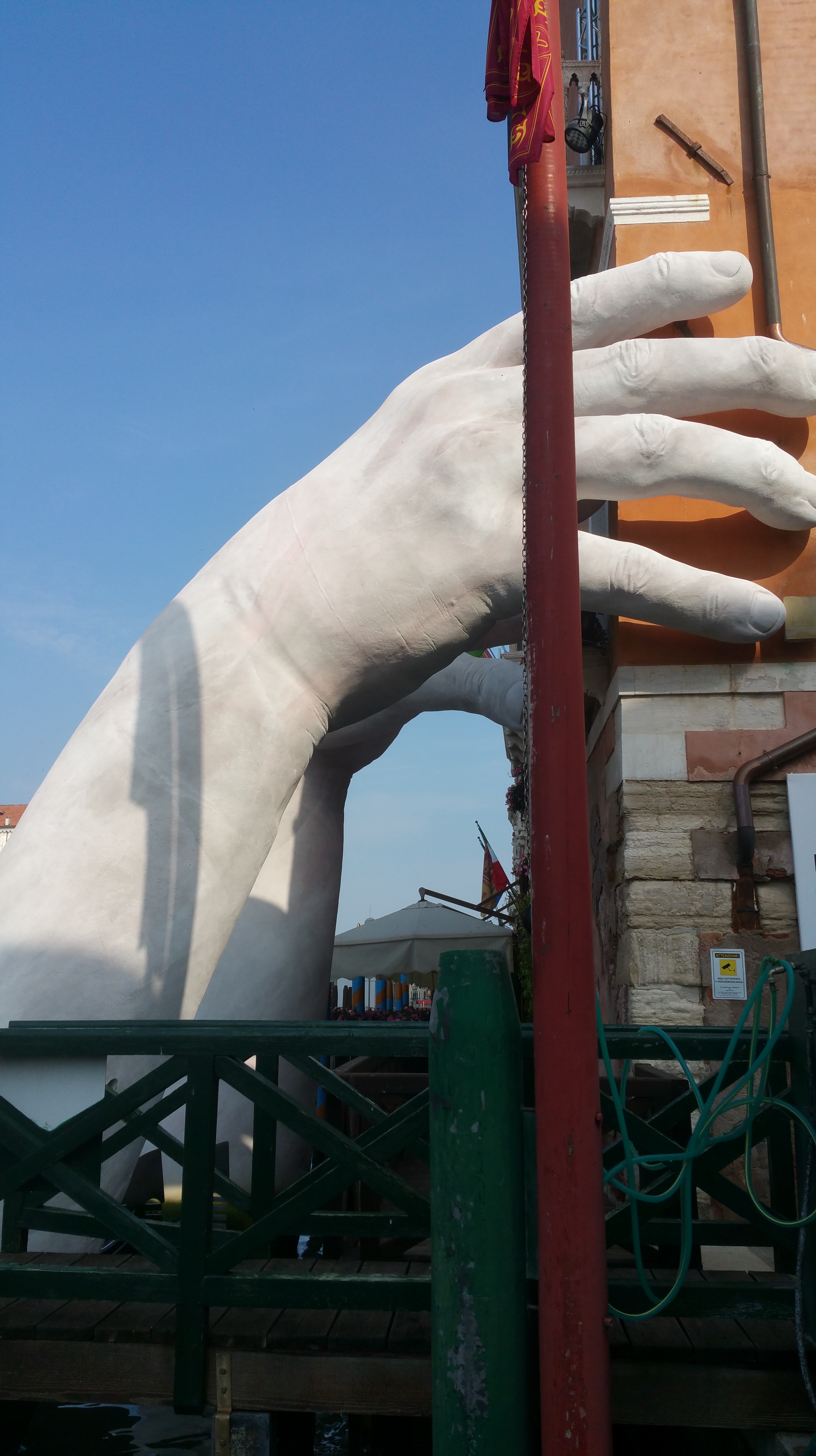
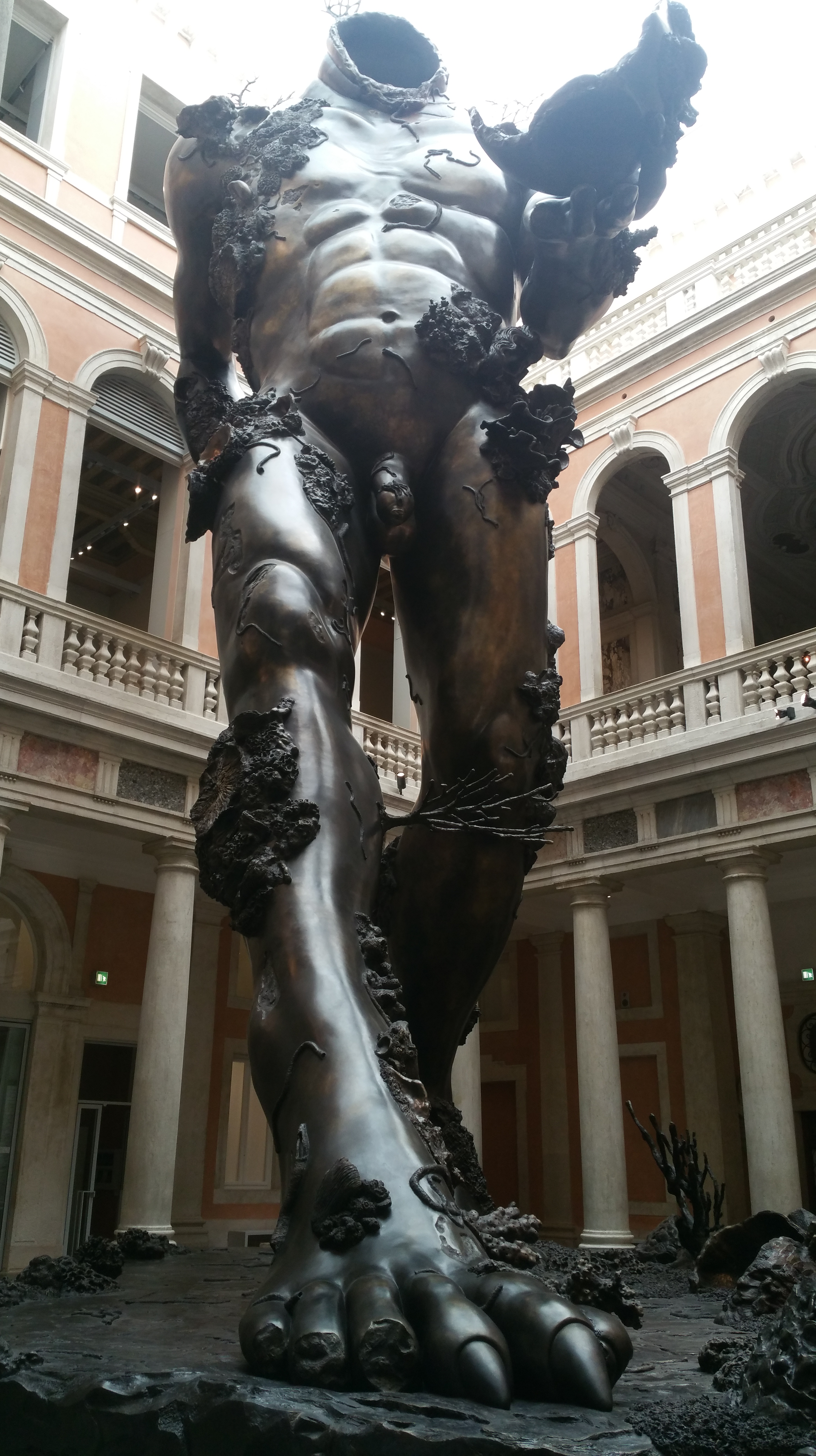




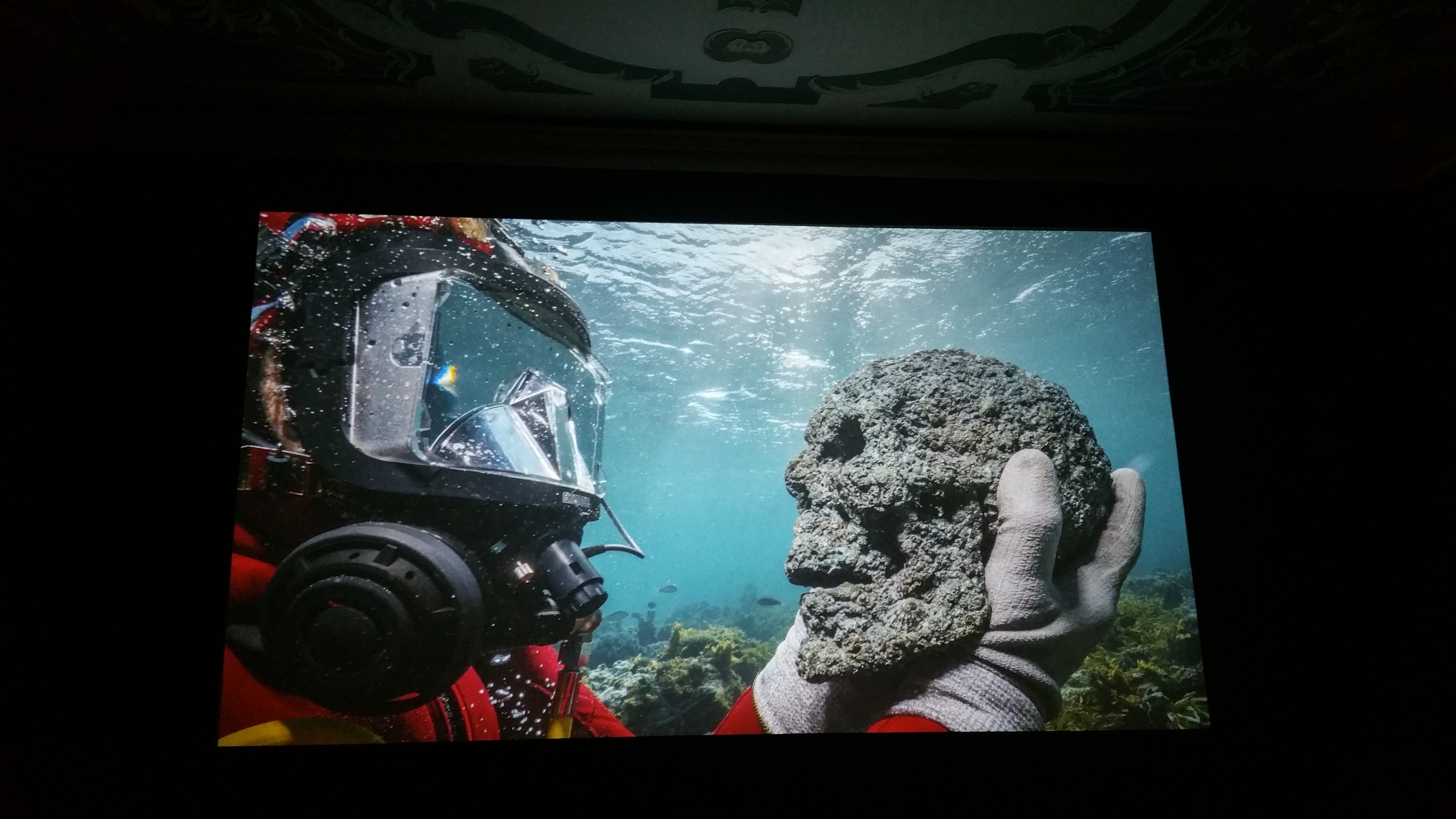
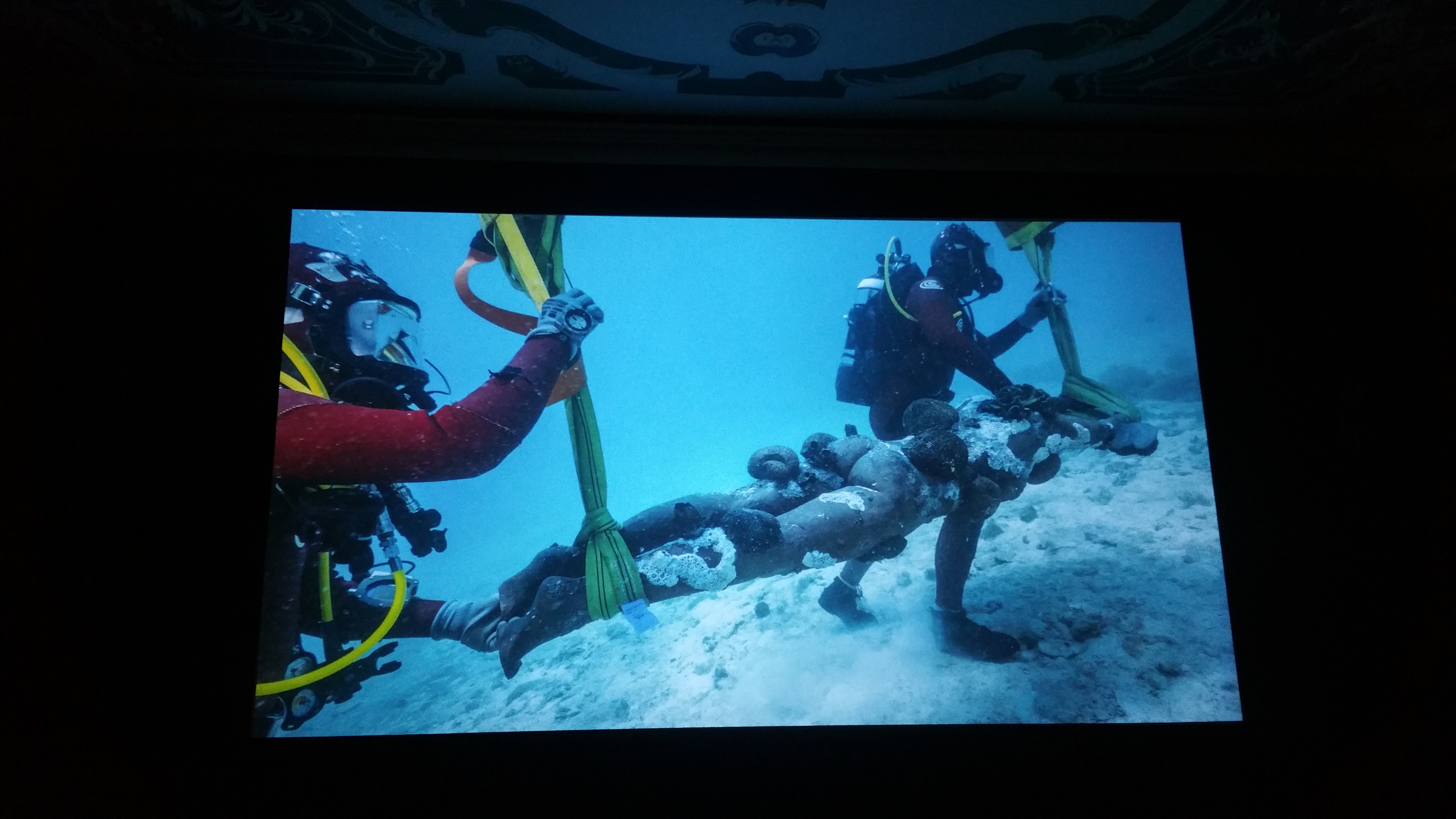
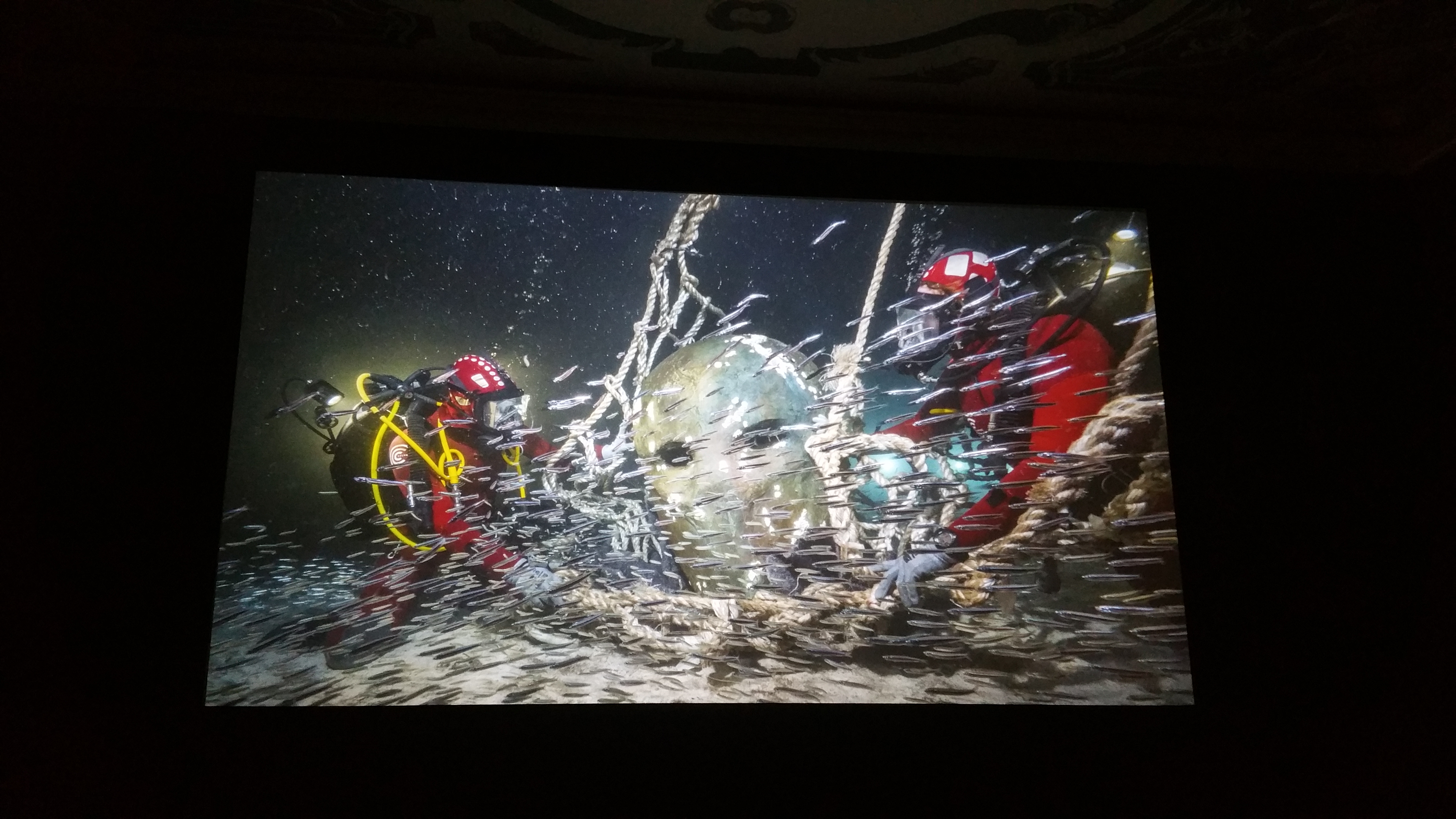
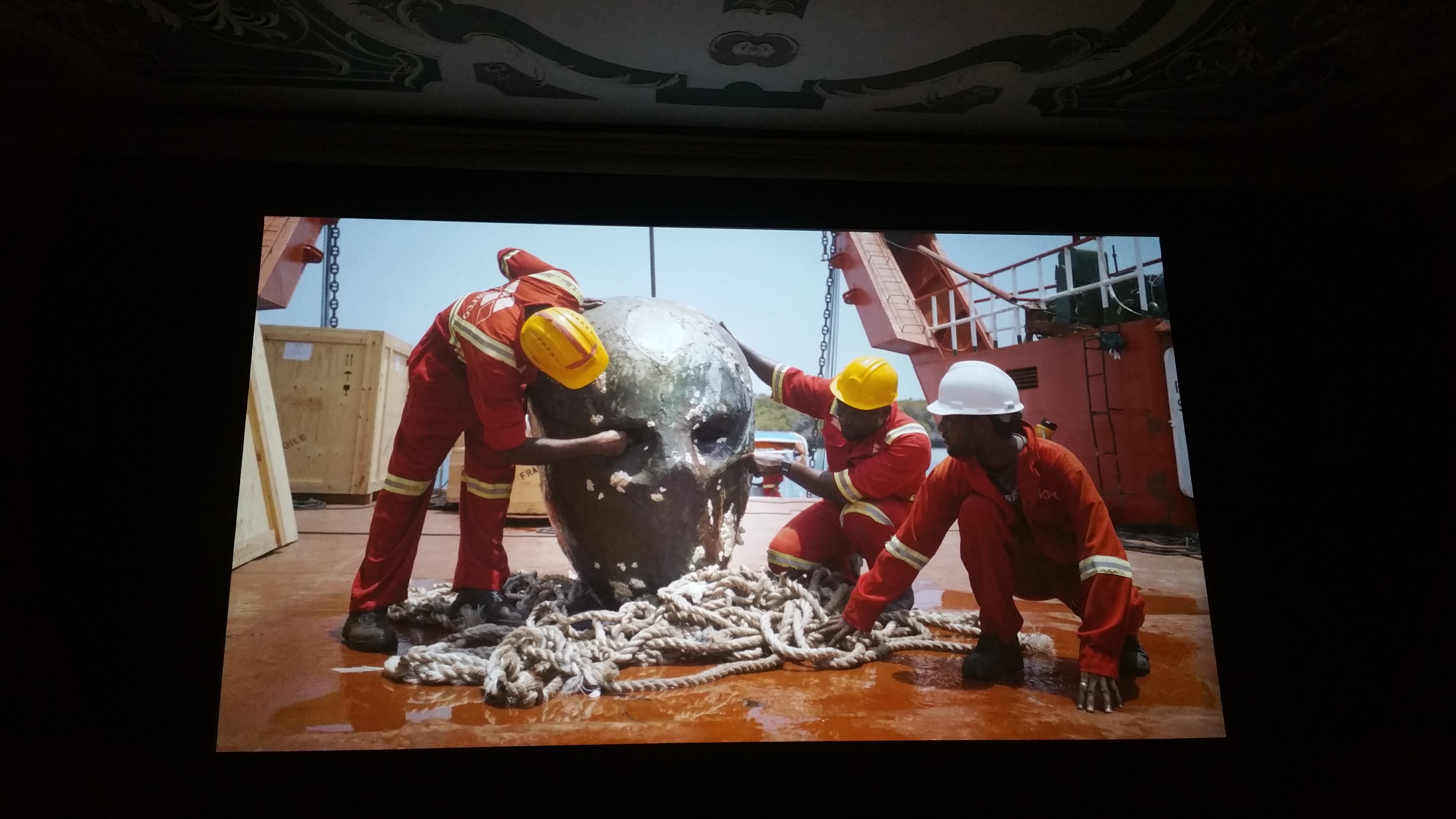
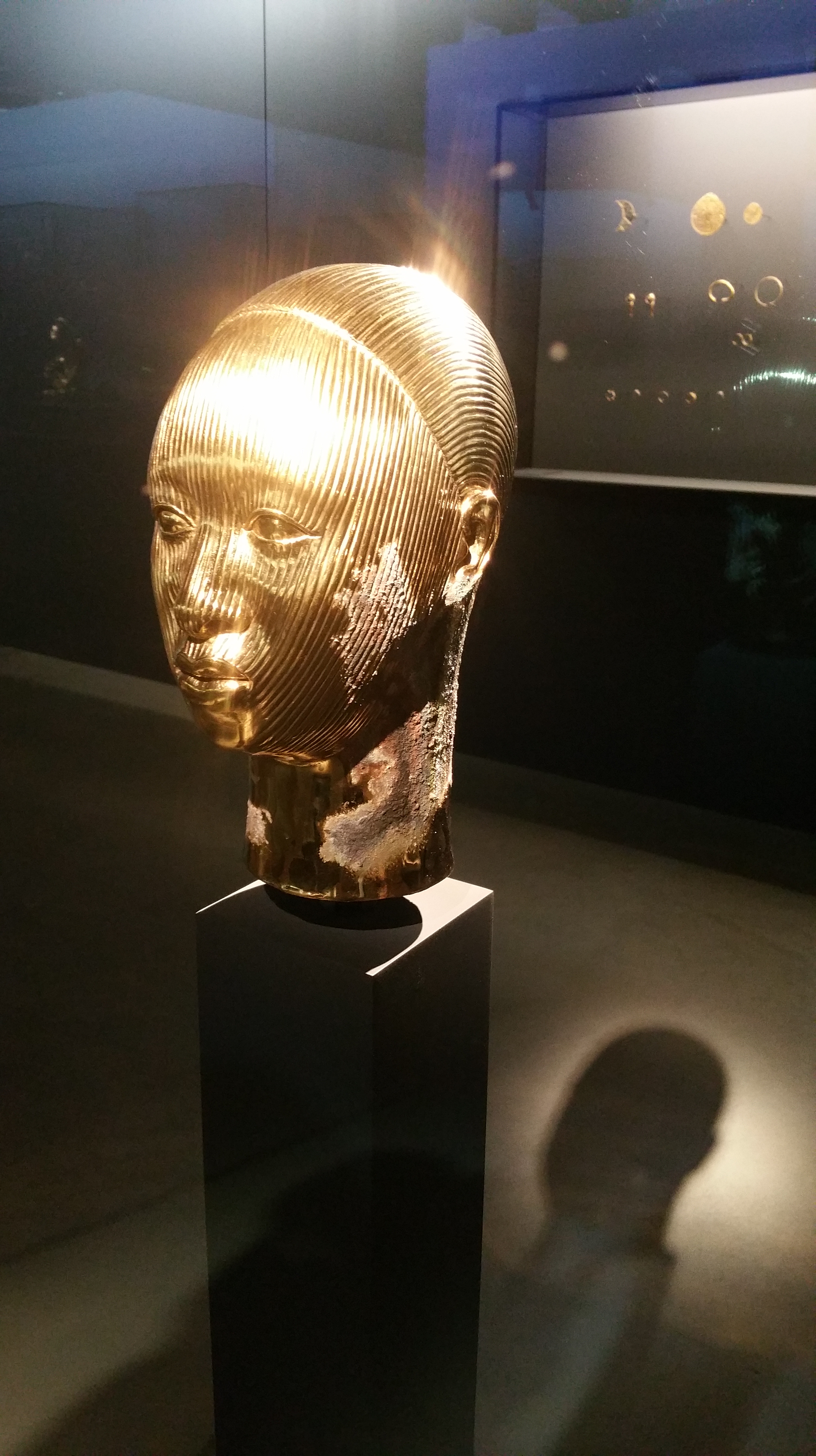




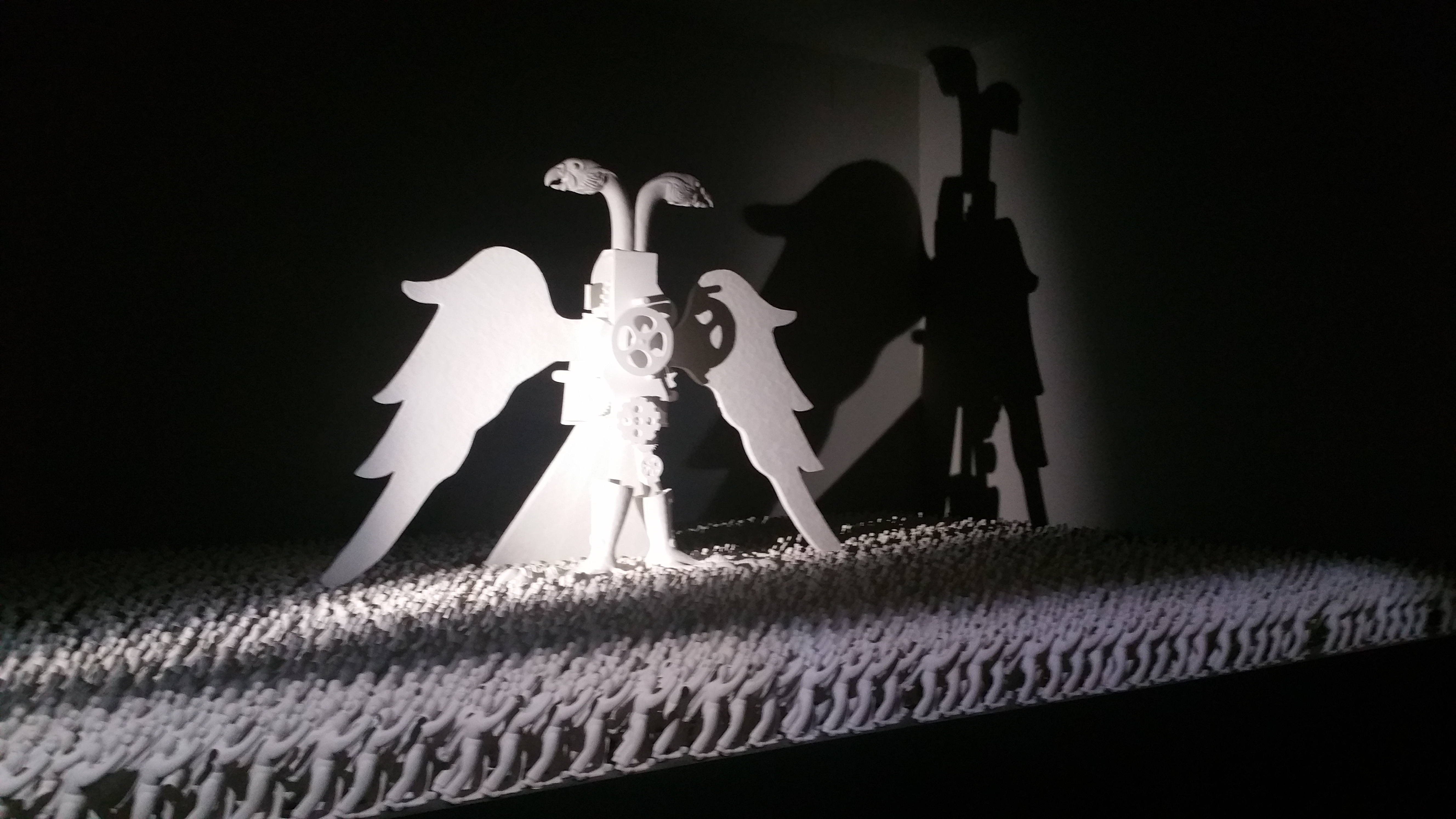
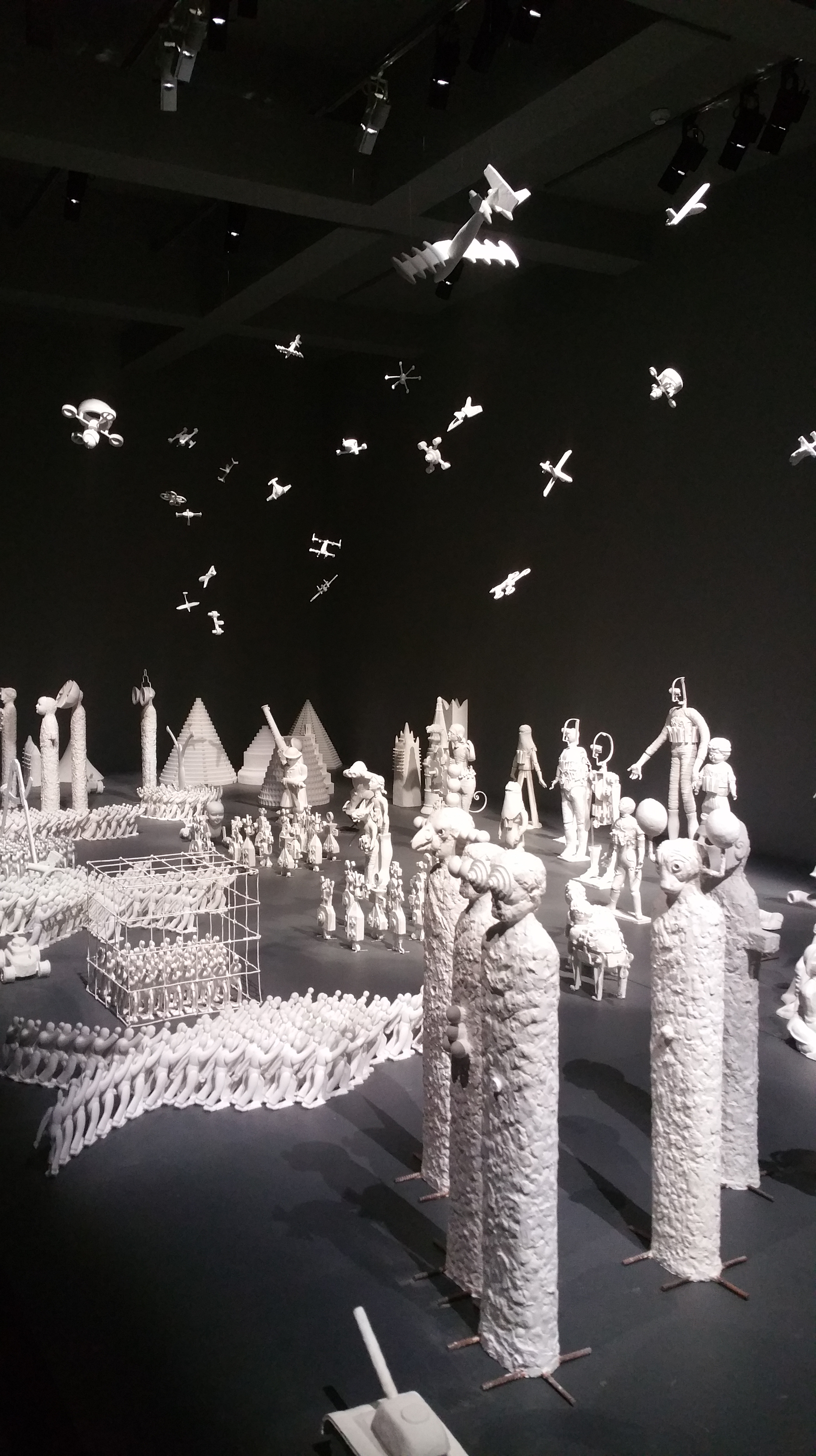 Russia’s Theatrum Orbis, commissioned and curated by Semyon Mikhailovsky. It consists of a variety of sculpture, installation, video and sound pieces, by artists Grisha Bruskin, Recycle Group and Sasha Pirogova.The title of the exhibition refers to Abraham Ortelius’ ‘Theatre of the World’ atlas (the first modern atlas), published in 1570 during Europe’s great age of colonialism and discovery.
Russia’s Theatrum Orbis, commissioned and curated by Semyon Mikhailovsky. It consists of a variety of sculpture, installation, video and sound pieces, by artists Grisha Bruskin, Recycle Group and Sasha Pirogova.The title of the exhibition refers to Abraham Ortelius’ ‘Theatre of the World’ atlas (the first modern atlas), published in 1570 during Europe’s great age of colonialism and discovery.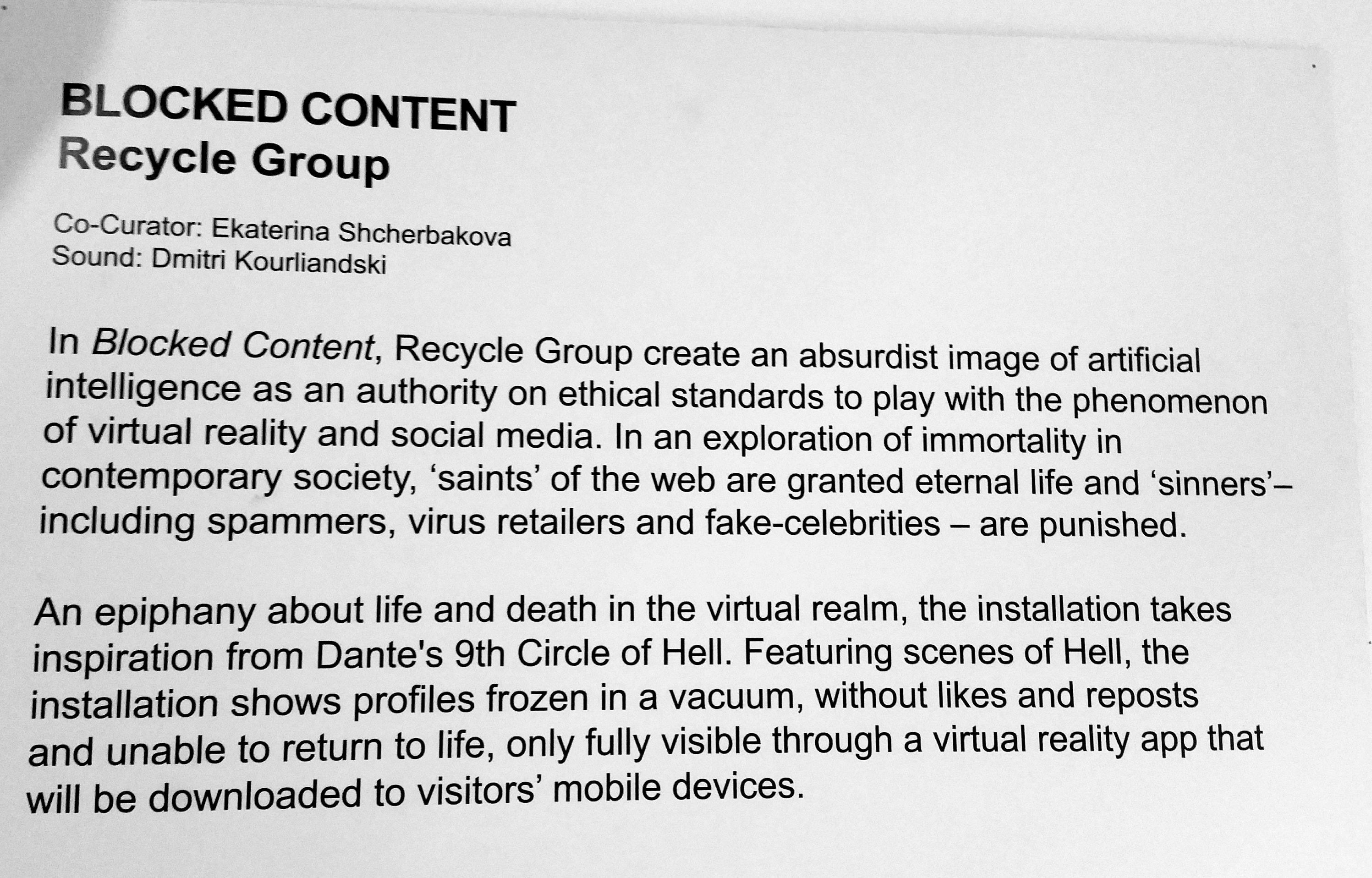


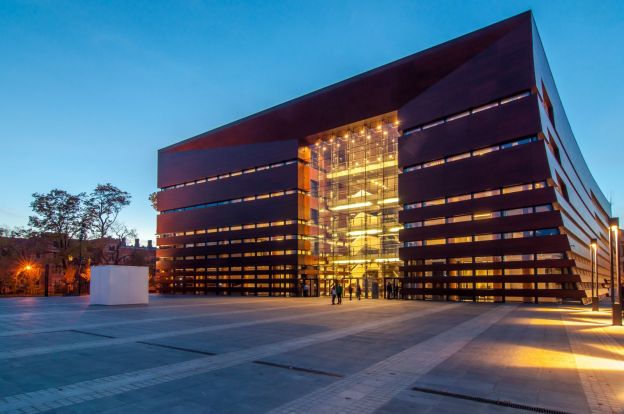







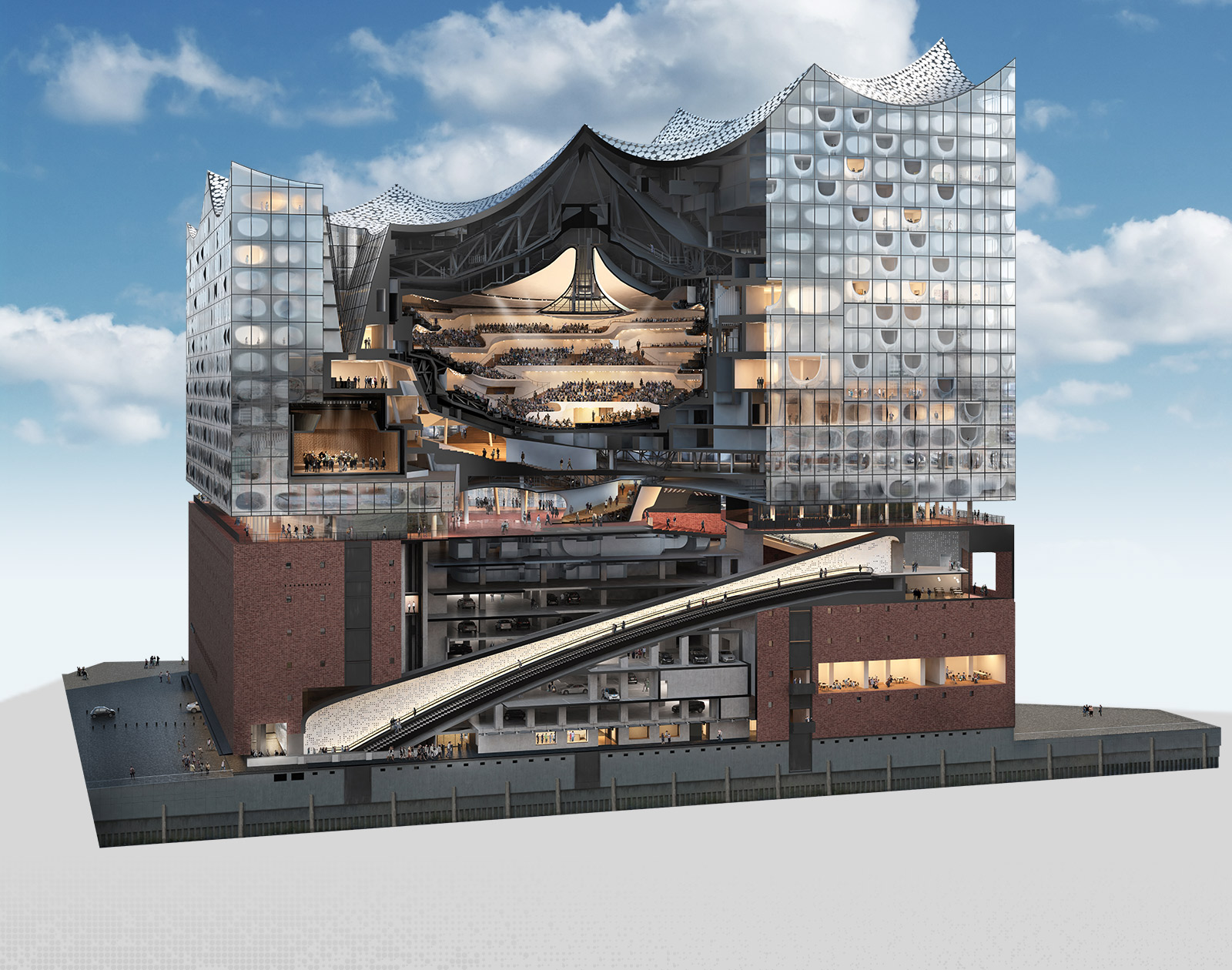 Exterior and Interior rendition of the new Hamburg Elbphilharmonie
Exterior and Interior rendition of the new Hamburg Elbphilharmonie Wroclaw’s new 1800 seater hall in the National Forum of Music
Wroclaw’s new 1800 seater hall in the National Forum of Music Interior of the new Dubai Opera
Interior of the new Dubai Opera





![20150113_185218[1]](https://marshallmarcus.files.wordpress.com/2015/01/20150113_1852181.jpg) Some of the hall’s acoustic baffles
Some of the hall’s acoustic baffles
![20150113_200841[1]](https://marshallmarcus.files.wordpress.com/2015/01/20150113_2008411.jpg)


